CWWK AIO-T6 NAS Review – Cheap and Cheerful?
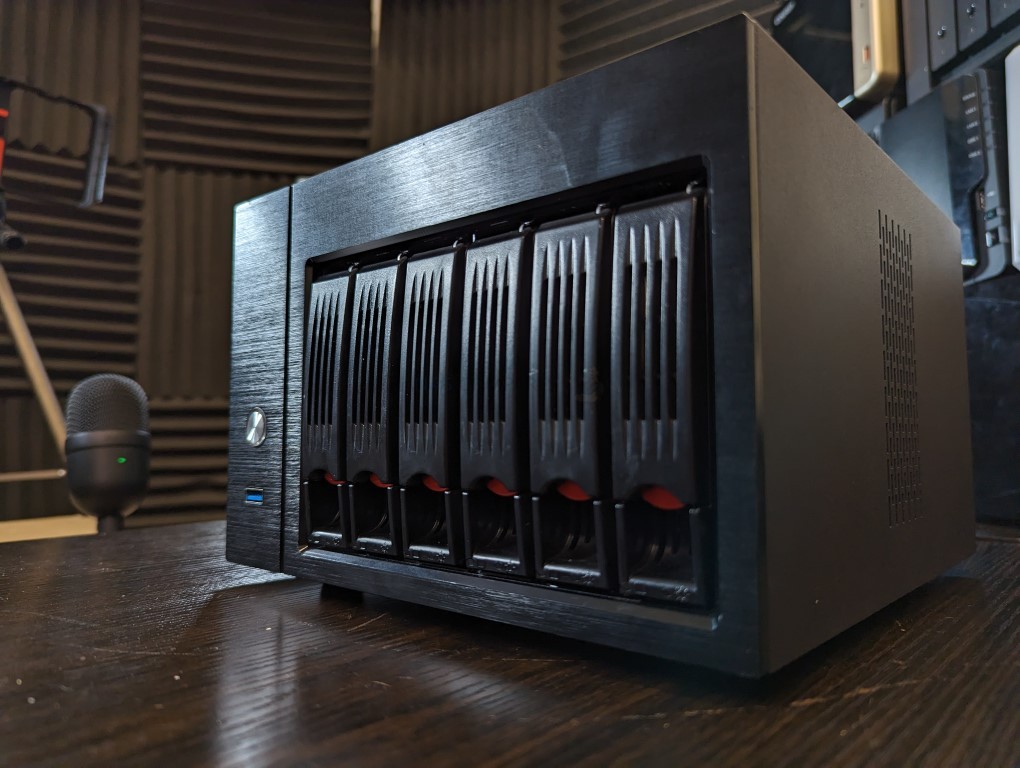
Who doesn’t love a bargain? Arguably one of the earliest hurdles that many NAS buyers will encounter when making the jump away from 3rd party cloud to hosting their own server is the PRICE! For some users (especially those of a PC literate background who built a few computers in their past) the price point of many NAS systems can be something of a shock. Reasonably, many users will look at the typical specifications of a NAS system and see modest CPUs, perfunctory memory quantities and small-scale stature in the casing and wonder “why do they cost so much?”. Now, we could talk all day about the work that goes into the design of a 24×7 system that might well be in operation for years and years, the durability of components, chassis design that optimizes storage and transmission speed above all else – all these things are true! However, the biggest factor in the price point of most popular NAS brands such as Synology and QNAP is the SOFTWARE and SERVICES! Typically referred to as ‘Turnkey’ or ‘Off-the-shelf’ solutions, all of the popular NAS solutions in the market are combined hardware+software solutions and arrive with a tremendously user-friendly setup and general use compared with more Do It Yourself solutions where you have to build the NAS from scratch and require open-source software (TrueNAS, UnRAID, OpenVault, etc). But what about a middle ground? What about a ready-built NAS solution that DOES NOT include an OS? Or one that arrives with an open-source (i.e FREE) NAS software like UnRAID or TrueNAS pre-installed? Well, THAT is exactly what has made solutions such as the ChangWang CWWK AIO-T6 NAS Drive get alot of attention lately. In the last 18 months or so, we have seen a huge increase in the number of OS-free NAS solutions and/or ‘good-to-go’ NAS motherboards by companies such as TopTon, as well as the ongoing development of similar Kickstarter solution Storaxa 5/9-Bay NAS+Router Solution (click for the playlist of videos) emerge to challenge the existing turnkey NAS market and (perhaps) form a new established and flourishing market between Hardware+Software NAS and the DiY+OpenSource crowd. But there, of course, one main question – are solutions like the CWWK AIO-T6 NAS actually any good? With a price point starting at £397 (the Intel Pentium 4-Core Model, 8GB Memory, 4×2.5G, 6xSATA, 1x 120GB SSD, HDMI/DP and UnRAID software ready), it is less than half the price of comparable solutions from Synology, QNAP, Asustor and Terramaster. So, let’s take a closer look at the system, what is included, what isn’t and whether we are seeing the industry change enough that it might deserve your data?
CWWK AIO-T6 NAS Review – Quick Conclusion
As a middle ground between turn-key NAS that force you to pay for H/W+S/W, or going full DiY from the ground up with open-source, the IDEA of the CWWK AIO-T6 NAS makes alot of sense. You are getting a ready-to-switch-on piece of 24×7 server hardware in desktop form, that arrives with better hardware than every other NAS solution at that same level, but 40-50% cheaper! For those users who are time-rich but money poor, this does offer another option beyond building from scratch when you might not have the skills to build, but you have the time to learn one of many different open-source software alternatives. In that sense, we need to see this area/tier of the storage industry get bigger and more populated. However, the CWWK AIO-T6 NAS is not the best example of this and, in many ways, actually makes the likes of Synology/QNAP/Asustor/Terramaster more palatable, simply by reason of a cleaner, better constructed and presented internal construction. There ARE some great examples of OS-free NAS servers available right now (not just scrappy ones on Aliexpress, but actually formidable alternatives that have grown from mini-PCs to real servers for home/SMBs), but the CWWK AIO-T6 has too many elements internally where they have clearly taken the internal hardware kit of existing stock and repurposed it in inelegant ways. I do think we are going to start to see some really interesting open-source ready-built NAS systems start to roll out in this burgeoning area of the desktop NAS industry (especially as globally, people are going to be a tad more selective about their spending), but the AIO-T6 is not the best example of this. I recommend going for the Topton/CWWK Mini PCs with the same board, but better utilized and presented.
Where to Buy a Product





![]()
![]()

VISIT RETAILER ➤






![]()
![]()

VISIT RETAILER ➤






![]()
![]()

VISIT RETAILER ➤






![]()
![]()

VISIT RETAILER ➤
 DEAL WATCH – Is It On Offer Right Now? DEAL WATCH – Is It On Offer Right Now?These Offers are Checked Daily
|
CWWK AIO-T6 NAS Review – Purchase, Shipping and Packaging
Normally in my reviews of NAS, I would never really touch on the actual ‘buying’ and ‘shipping’ of an item (just the actual protection, normally). However, in the case of the CWWK AIO-T6 NAS, I need to make an exception! This is because you cannot actually buy this system outside of Chinese outlets and AliExpress. Originally appearing on the Tmail/TaoBao website here a while back, it wasn’t long before it started appearing on the Aliexpress pages alongside TopTon boards and OS-free Router boxes that were pfSense, OpenWRT ready. Arriving with a pretty customizable range of default configurations in CPU/Memory/SSD, even at the highest listed specs we are still talking small granular increases of £25-35 for fairly substantial increases in memory and base level included SSD. It’s also worth highlighting early that the UnRAID software was trial locked at 30 days (at least, that’s what I found later in installation with no means to scale up to the Pro licence) and was little different from the version available on the UnRAID site here. I have since had communication with UnRAID and they quickly confirmed all suspicions that they had zero affiliation with this product in any official capacity (shocker), but that’s not a huge surprise (custom opensource installed build NAS’ are currently ten a penny on AliExpress and eBay). The CWWK AIO-T6 NAS was ordered on February 23rd, with free delivery (no option to upgrade) and arrived on March 10th. For the ‘TAX’ curious, the device arrived without any deliver side duty/tax payments or invoice requirements – There was no included invoice in the documentation and there was a few re-labels that suggested that this box went through a transit point (container shipping and redistribution?) that suggested that it avoided local tax/duty commitments in one way or another. Again, I am by no means a customs expert!
Now, the first thing we need to discuss is the packaging that it arrived in – always a concern when buying things that are suspiciously cheap OR of a decent weight that are shipped internationally ‘free’. The shipping container was a repurposed cardboard box (cut down to size) and massively enveloped in brown tape! Again, not a huge surprise as its a low-cost purchase, but it definitely immediately sets the stall out early that this is a budget shipped solution. Still, its what’s inside that matters!
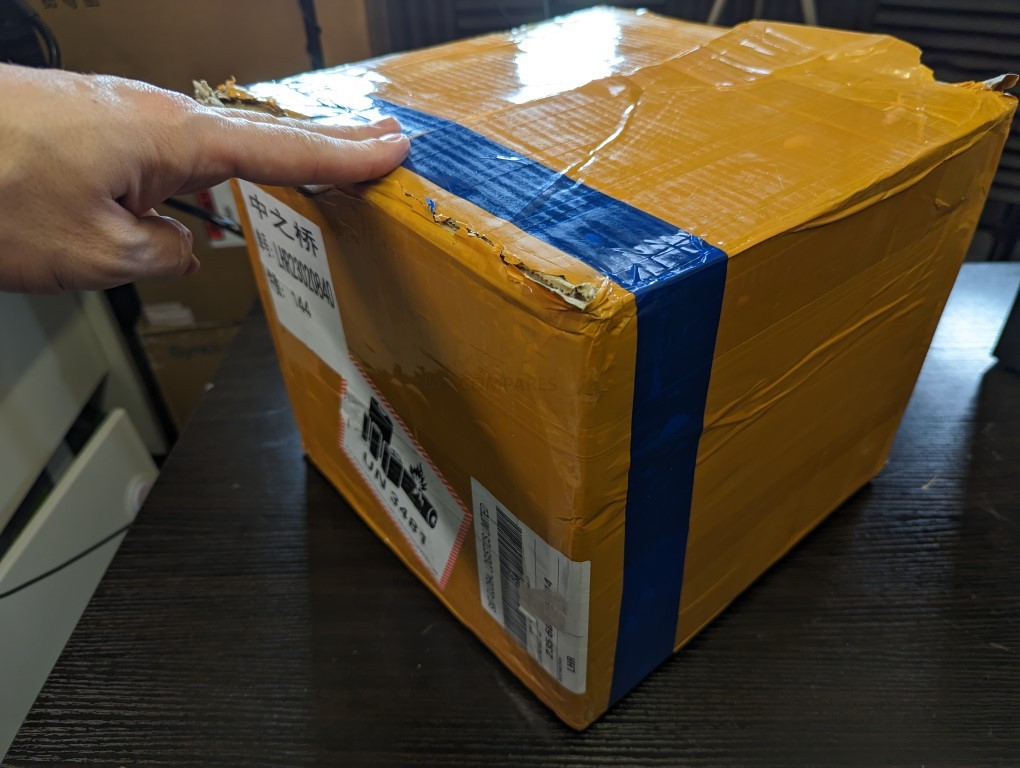
Inside the tape covered packaging, we find an unbranded retail box that is largely the same structure as most other NAS retaill kits, but the cardboard is single layer and the foam is alot softer. Still, this is several times better than was expecting when I saw that shipping container and definitely enough to protect this device in transit. That said, had I selected any kind of prepopulated HDD option and it arrived like this – those drives would have had their SMART/Sectors checked immediately! Decent enough protection for an unpopulated box, though.
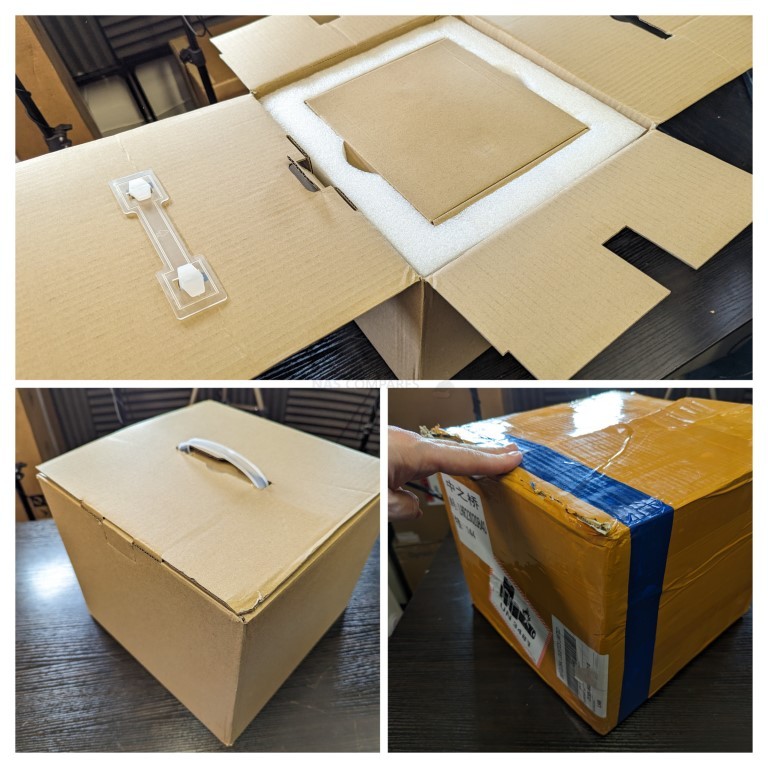
The retail kit of the AIO-T6 features pretty much everything that you would expect in it’s accessory kit, as well as the included memory and M.2 NVMe SSD upgrade arriving pre-installed. The instruction manual is pretty ‘low rent’, with slightly weak translations and the diagrams appeasing from a completely different product (the smaller formed CWWK/Topton fanless mini PCs) but this is not unusual.
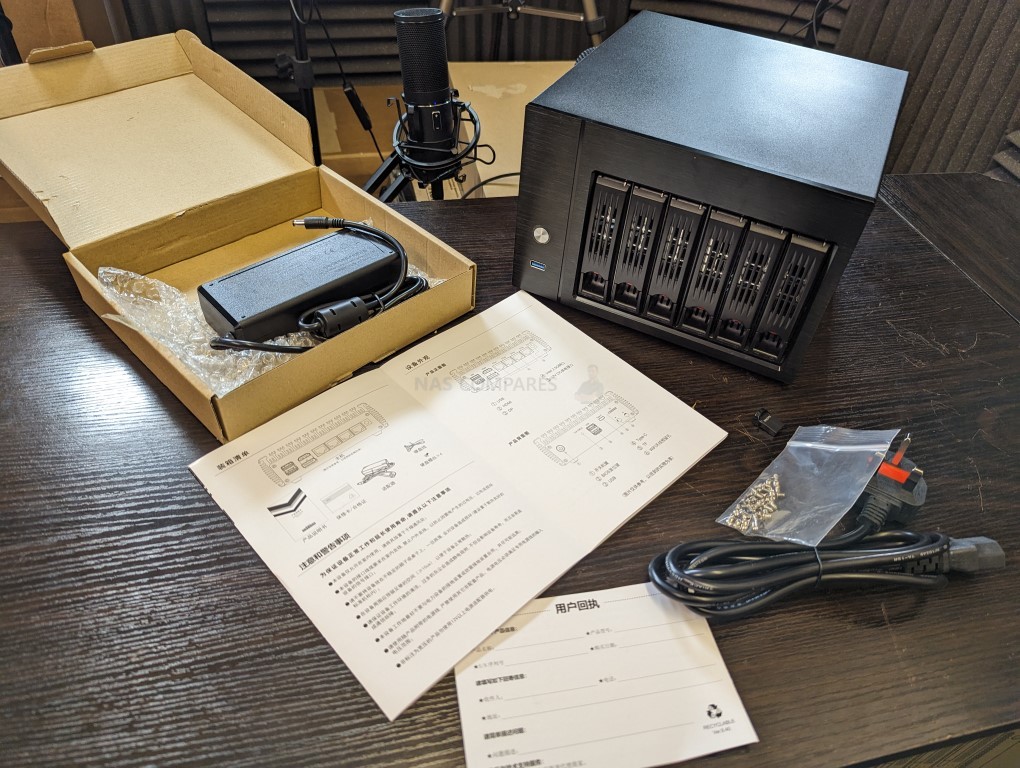
The contents of the AIO-T6 NAS kit include:
- The AIO-T6 NAS NAS itself
- An external 120W PSU
- Instructions
- Mains power cable
- Screws for 2.5″ and 3.5″ media to be installed
- A Sansdisk USB Drive
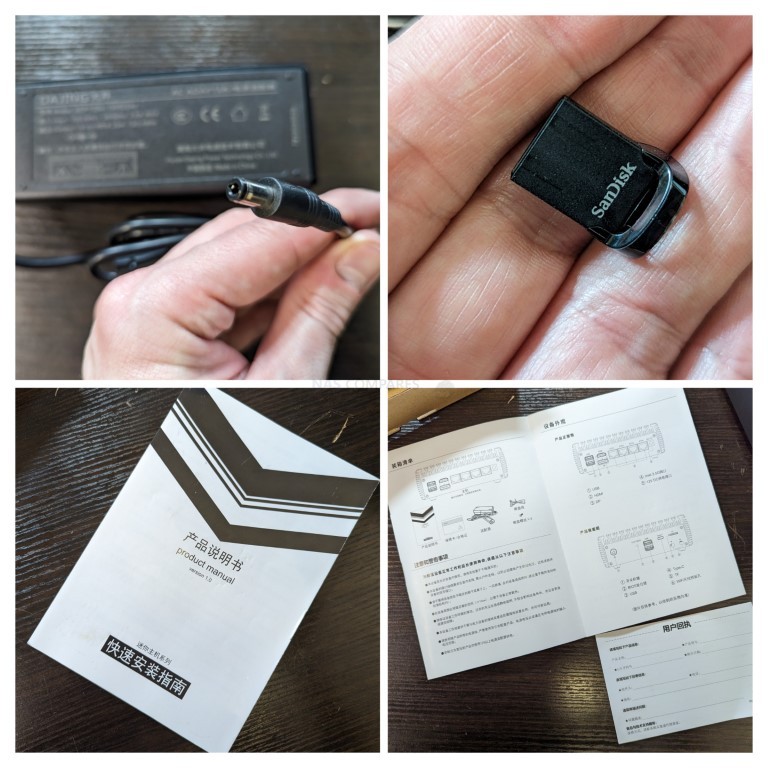
The included USB drive is what contains the UnRAID installation and you need to have that when booting the device up for the first time. This si what will complete the initialization and allow the system to run UnRAID with the available six SATA bays and M.2 NVMe bay. Although those familiar with UnRAID will know that the software runs for the USB (can be migrated/exported later if needed technically), alot of new users may not be too aware of this, thinking this to be a recovery USB, and also equally unaware of the keyboard+video requirements of initialization on fresh installs. This is ‘sort of’ covered in the manual for newer users, but it is not exactly clearly indicated (down to the translation and presentation of the information being inconsistent) and I can definitely imagine alot of new users falling at this first hurdle. Again, those already versed in UnRAID and general Open Source server initialization will not even bat an eye at this, but unseasoned private server storage users will find this a little bit of an early bump compared with the comparative hand-holding of turnkey OS-included NAS solutions from established NAS brands.
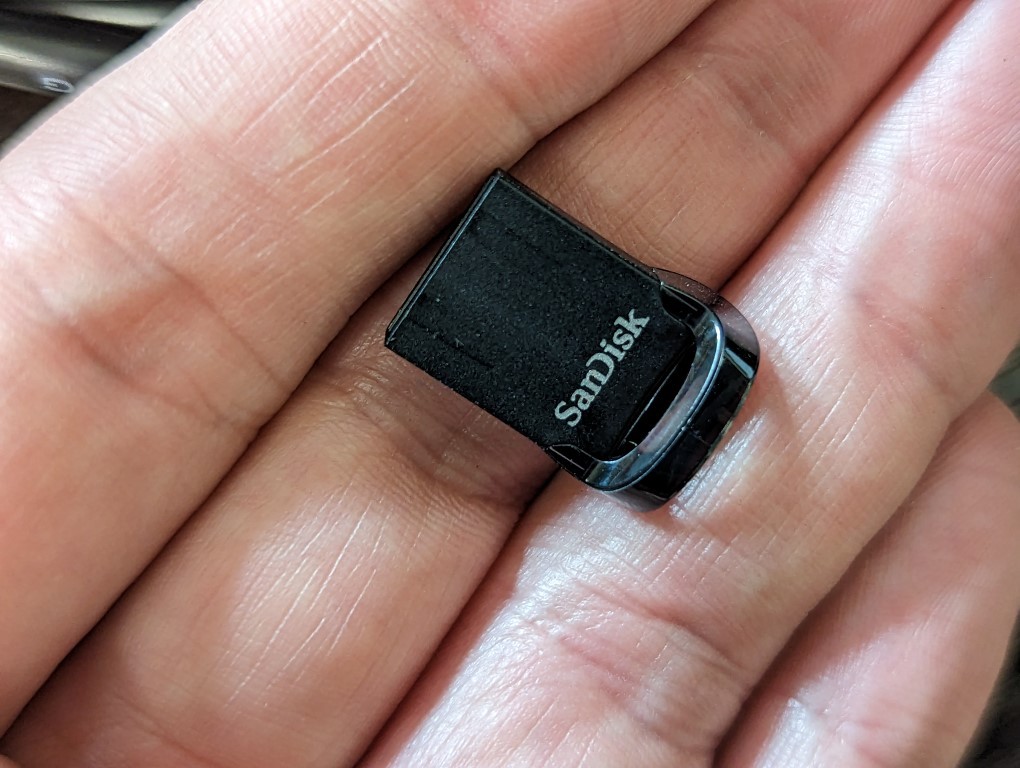
Overall, although the initial impression of the shipping box that I ordered was far from stellar, the actual contents are comparable to what you would expect from the likes of Synology or QNAP – just lacking alot of the polish and confidence of those. That said, these are all day-1 impressions and the really important thing here is how the system’s design and accessibility fare. Let’s discuss the design of the AIO-T6 NAS and see if the clear savings in this OS-free NAS are noticeable.
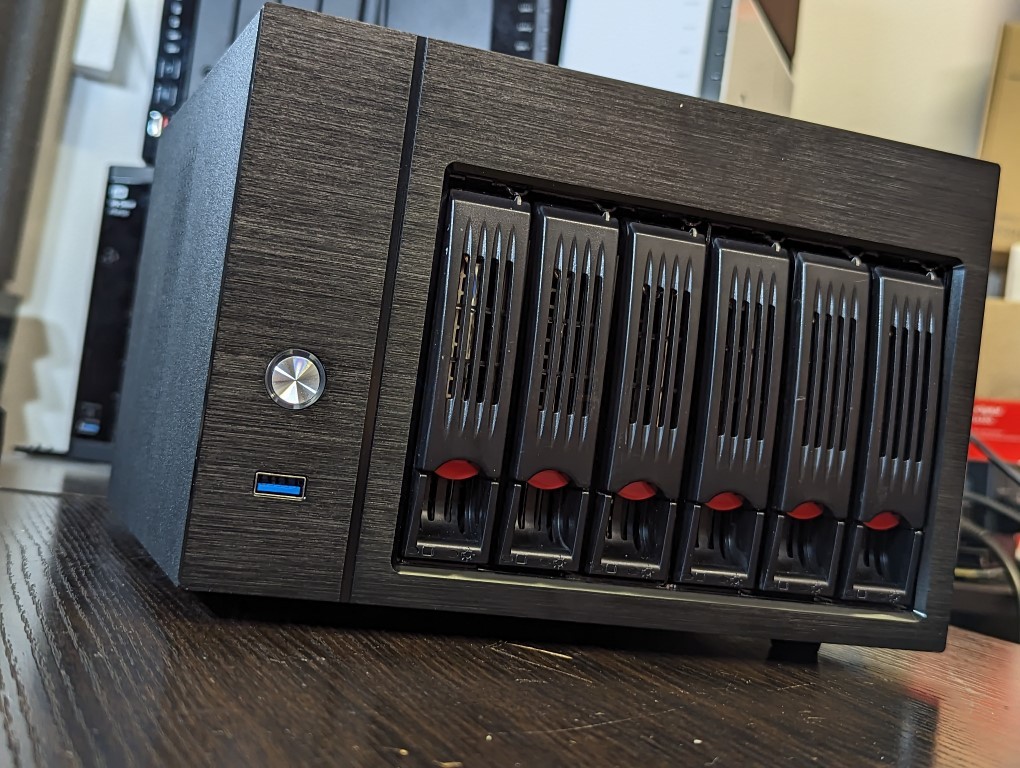
CWWK AIO-T6 NAS Review – Design
Ok, so I am gonna get this out the way early doors. I actually quite like the chassis of the ChangWang/Topton CWWK AIO-T6 NAS. Yes, it definitely has a “let’s cut 10,000 quickly on a conveyor belt” kind of feeling about it, but for a 6-bay chassis that comfortably arrives at 40-50% or less than the price of the Synology DS1621+, QNAP TS-664, Terramaster T6-423 and Asustor Lockerstor 6 Gen 2 – the build quality feels quite sturdy. The front of the chassis features a brush steel-ish panel (no LCD panel) and the power button feels very ‘clicky’, but there does seem to be a good degree of horizontal ventilation and if I was asked to draw an unbranded 8-bay NAS chassis, this is pretty much what I would have drawn!
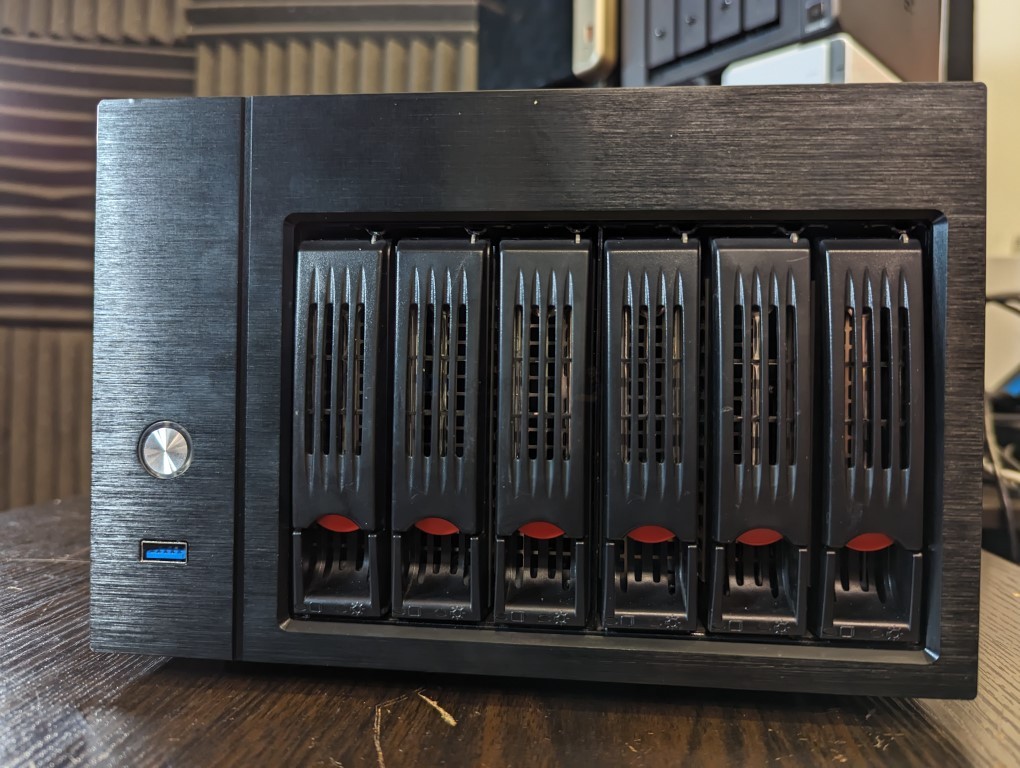
The scale of the chassis is also very similar in size to the QNAP and Asustor NAS I mentioned earlier, and the fact the bulk of the chassis external is metal will definitely assist heat dicissipation. Equally, the casing, although definitely feeling like it was cut in a rush, does fit well, without the inevitable alignment issue that alot of cheap cases have when removing/replacing the outer casing. Later on when we go through the internal hardware, you will likely see why I am pleased about heat dissipation via the metal chassis, but for now we need to discuss ventilation.

The system arrives with fairly standard ventilation provisioning in the casing. The twin rear fans (technically adjustable in RPM, depending on the software you choose to install) are nice and large, as well as the side panels of the system both feature vent panels. All fairly standard design, but still nonetheless gladly present in this value package.
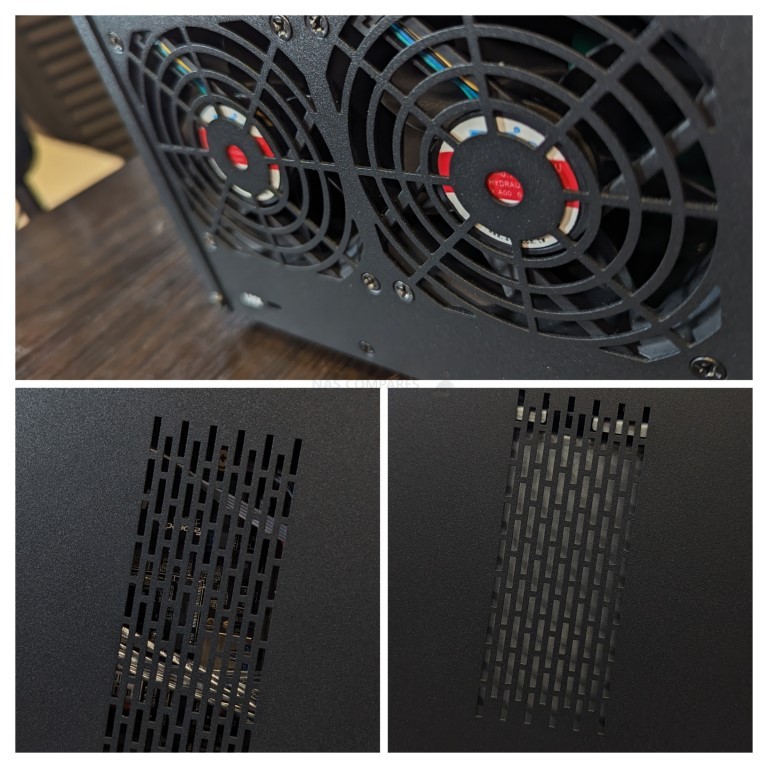
Additonally, the main SATA storage bays all feature ventilation strips and (again) this is another area of the physical design that I was pleased with – as ALOT of the cheaper OS-free NAS enclosures I have seen over the years have exceptionally cheaply made trays. Something that is not the case here and (if anything) better quality in design than several of the 6-Bay options available from one or two of the established NAS brands.
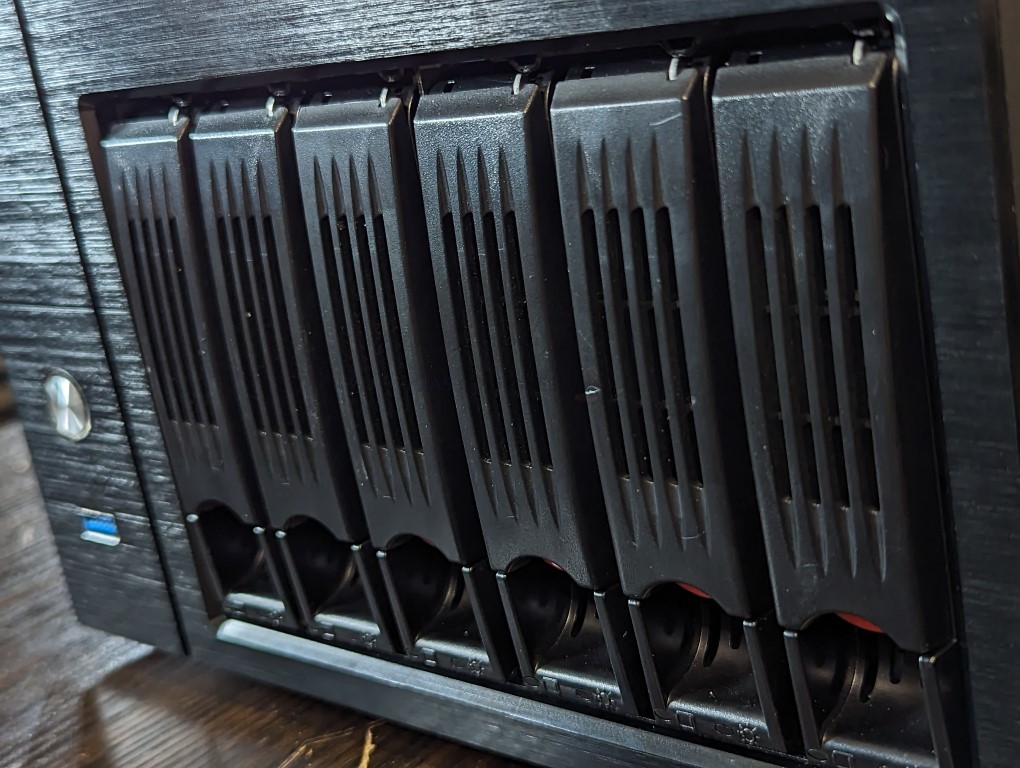
The trays themselves are metal, springloaded and pretty well cut. They are not click’n’load and lack any locking mechanism, but they do still feel like a study tray for your media – far more comparable to rackmount trays and feature the standard 3.5″/2.5″ screw holes you would expect. Also, each bay features twin LEDs for connection and activity when the system is in operation. Again, not exactly groundbreaking BUT definitely still a welcome surprise.
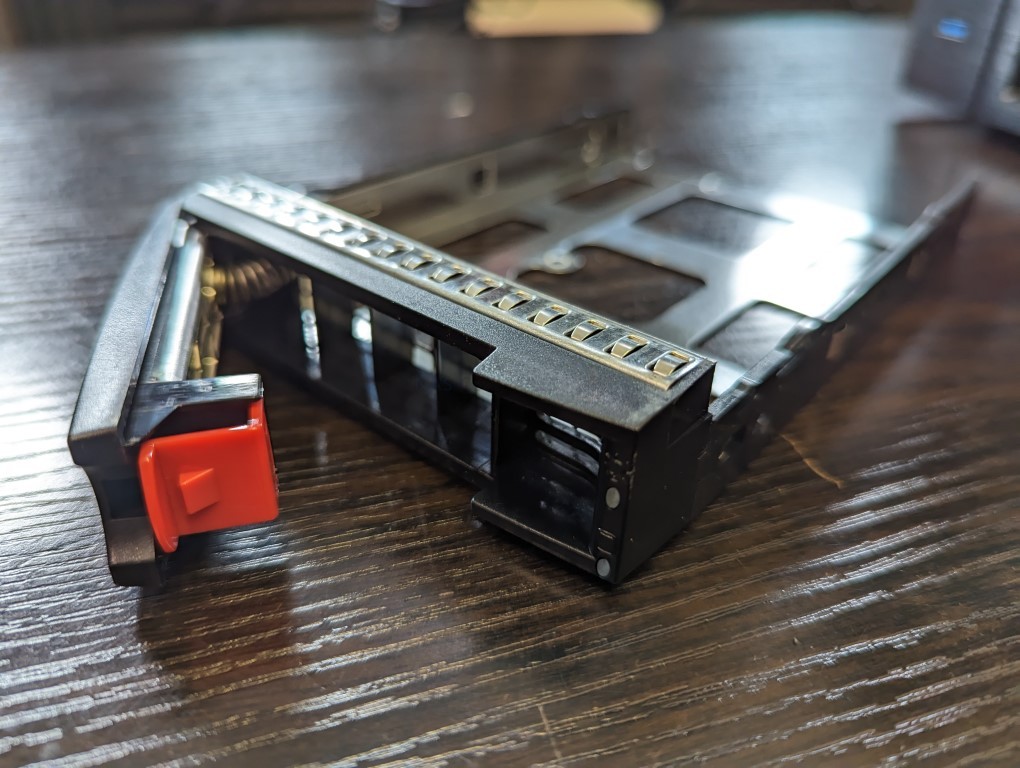
All this said the cavity for the six SATA drive bays does leave a little bit to be desired. On the positive side, each of the six slots has guidelines that ensure a smooth connection with the dual SATA/POWER connectors and this backs directly onto active cooling fans (with further surround vents around them). But the cavity is divided into two 3-bay blocks with a metal divider and even after the system was in operation for a few hours, resulted in the drives getting a pinch hotter than I would have expected. Additionally, the inside just seems very poorly coated and definitely gives you the feeling of that ‘rushed cutting’ feeling at production. In itself, this isn’t a big deal, but with a decent amount of metal dust on my finger tips even after just a few minutes, this was one area where the device did feel a bit cheap in its chassis. Again, this could easily just be a one off with this device, but I doubt it.
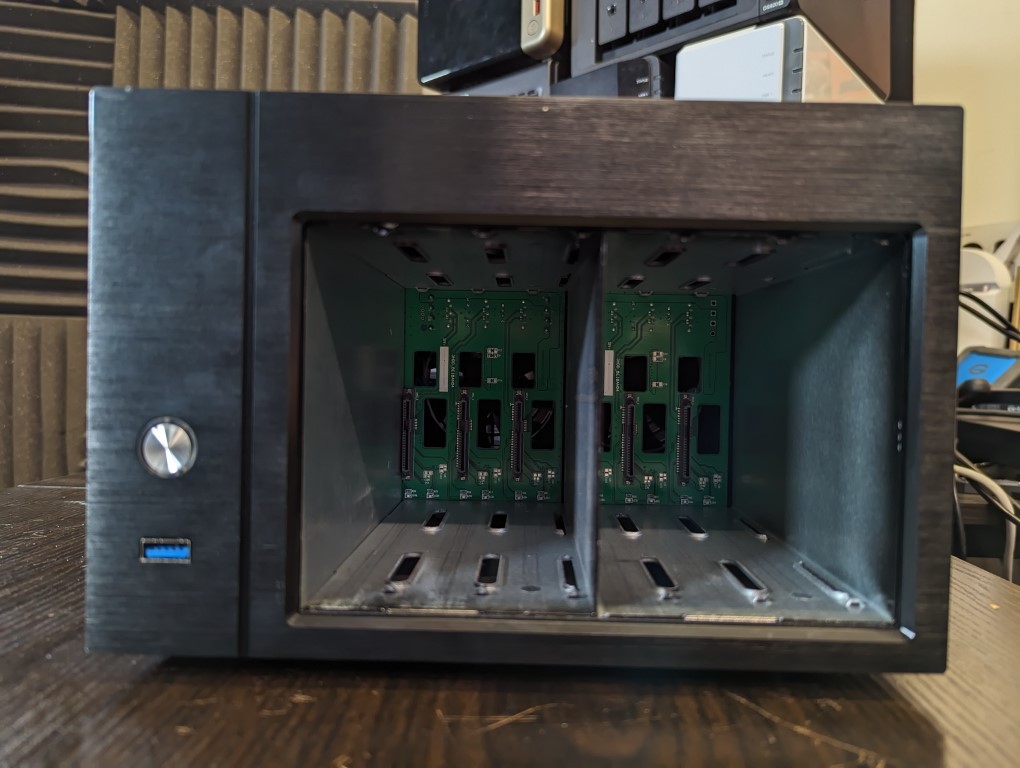
The front-mounted USB was a nice, small and arguably unexpected hardware design point. Not exactly re-inventing the wheel, but it was still good to see and although lacking any kind of one-touch backup/dismount button, was good to see here. Indeed, USB support and external storage connectivity that is surprisingly broad on the AIO-T6 NAS and, in some places, massively overlooked that point of sale/specifications (possibly for reasons of board modifications and chipset), but more on that later.
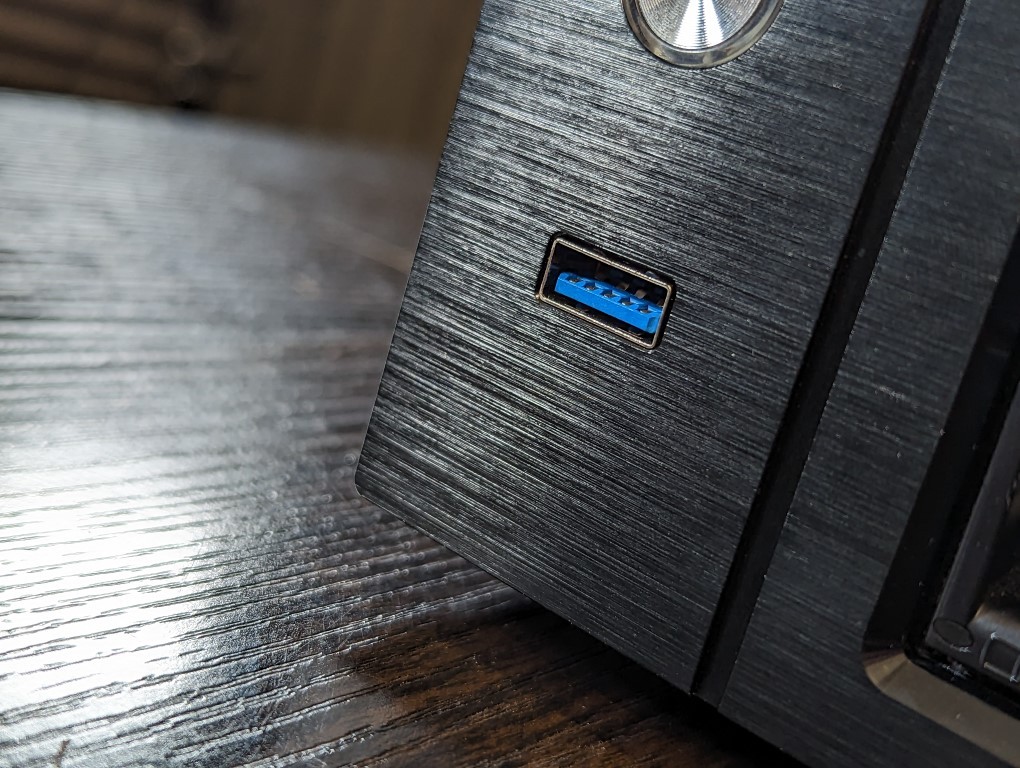
The design of the CWWK AIO-T6 NAS is ok for hte price point. I would not say it looks premium and it has the feel/shape of an unbranded solution just waiting to be adopted by a 3rd party to slap their logo on,BUT, it is by no means ugly. Equally, although the casing does seem to have been bulk produced quickly on mass with a lower Q.C than some of the bigger brands might have had, it is alot BETTER than this price point would have indicated. Let’s discuss the ports and connections of the CHANGWANG AIO-T6 NAS.
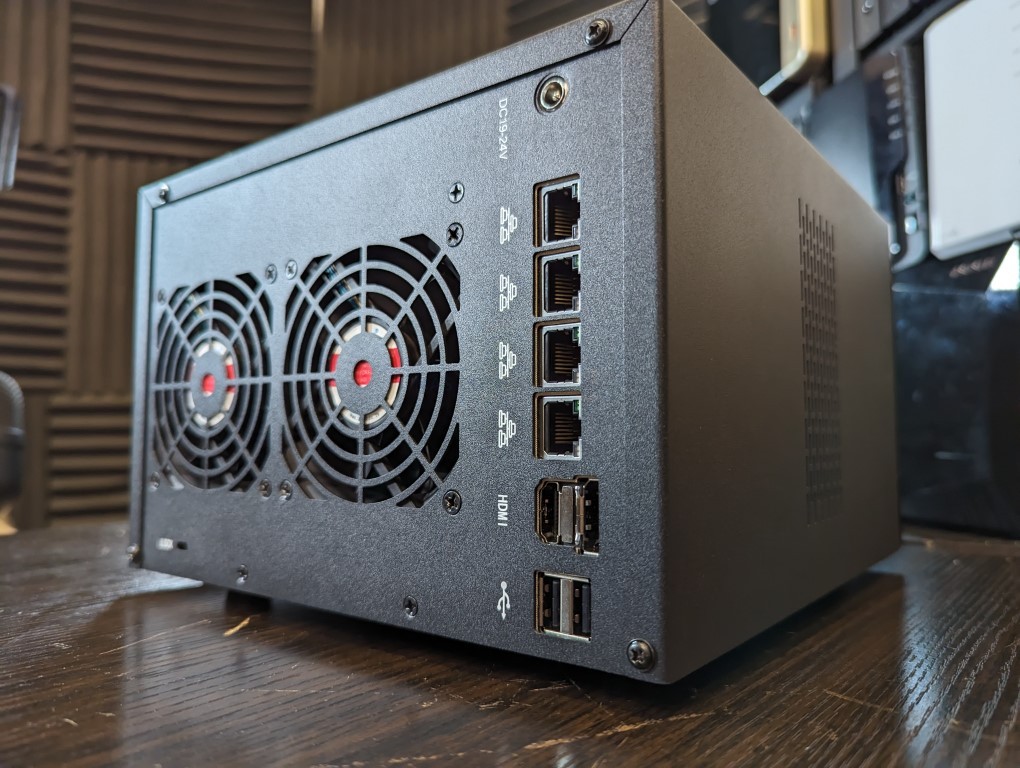
CWWK AIO-T6 NAS Review – Ports and Connections
If there is one element of the budget/OS-free solutions available on sites like AliExpress, it is the sheer scale of value for money offered in the internal and external hardware. If you have already decided that open-source software is the way you want to go, then you are going to want to make sure that even Pound/Dollar/Euro you spend goes onto that hardware as effectively as possible. The ports and connectivity of solutions built on Topton and Changwang/CWWK solutions that have appeared online (thanks to a combination of tactical PCIe Lane distribution and on-board embedded components) are genuinely in a different league compared with those of turnkey NAS solutions that need to constantly need to walk that balancing act between the cost of the solution and their hardware+software commitments. The AIO-T6 NAS is no exception here, arriving with a rang eof connections that are simply not available in this configuration from Synology, QNAP, etc.
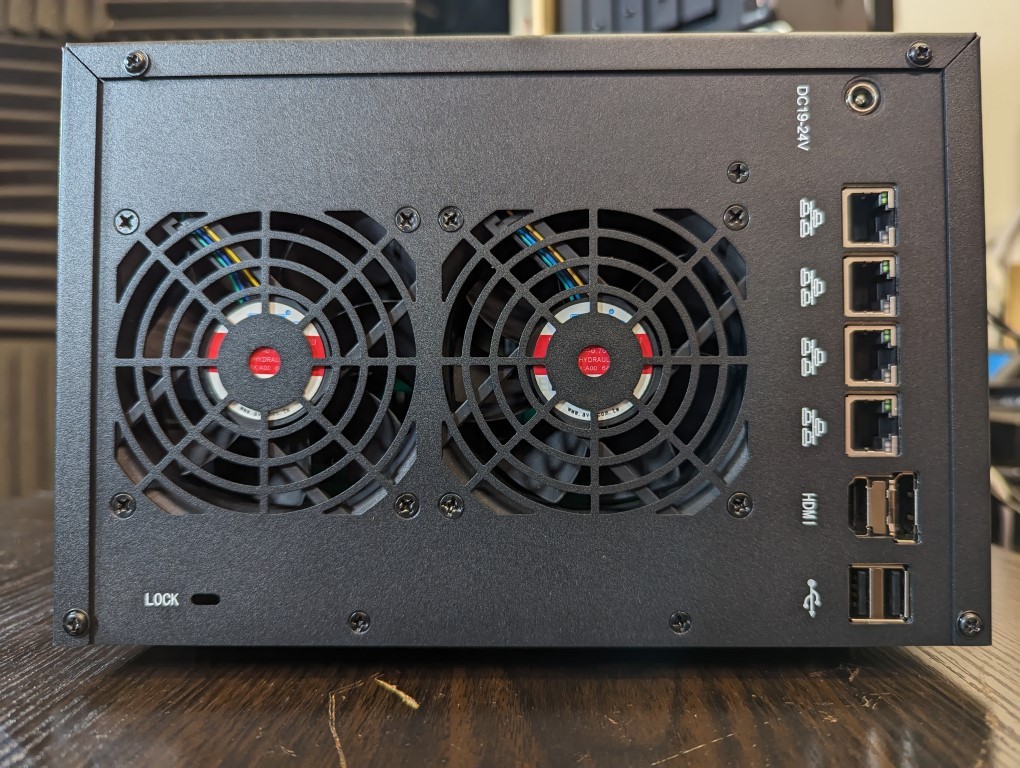
The first big point here is the four 2.5Gigabit connections. Now, arguably what you are able to do with these will depend on the NAS software you choose to install onboard (whether it is running with the inclusive UnRAID software or going custom towards the likes of TrueNAS, Openvault or go multi-OS with Proxmox and introduce pfSense or OpenWRT network management perhaps). At the very least, you certainly have four 2.5GbE ready connections here. The four Intel i225-V B3 2.5G RJ45 LANs are all well-soldered and are not based on a separate board/card.
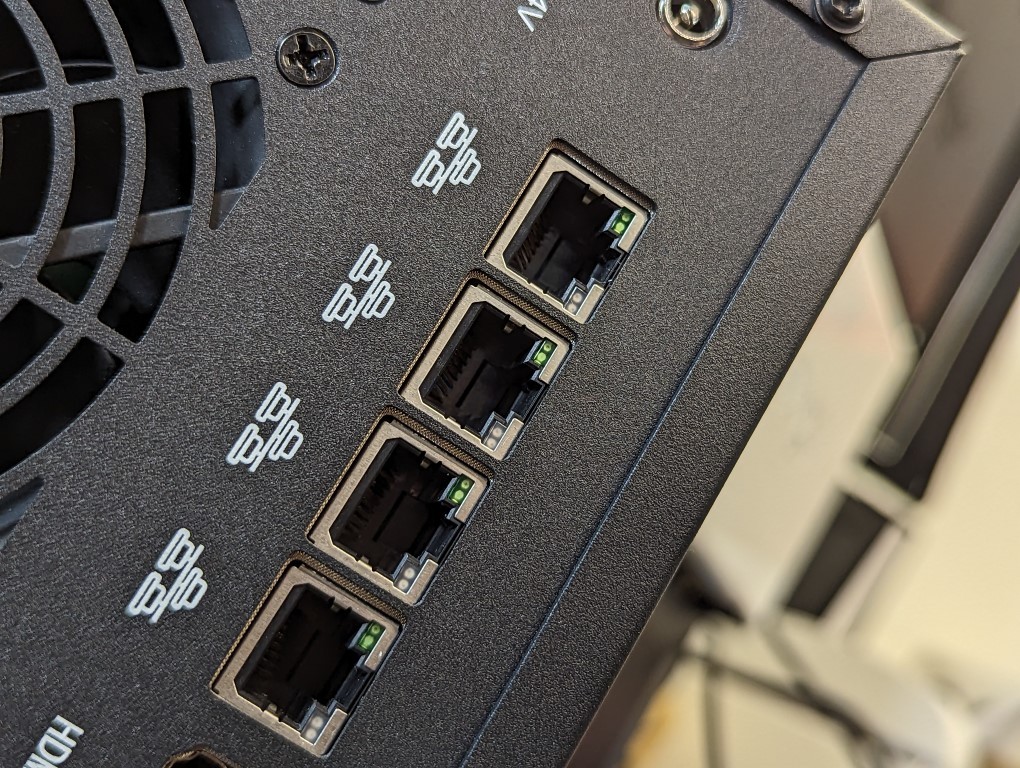
Additionally, there are two further USB ports (USN 2.0 Type A) at the base of the back. Clearly these are peripheral/Keybard-video-mouse connections, but then again you might have better ideas for these with the right NAS OS in place.

The CWWK AIO-T6 NAS also arrives with an HDMI 2.0 4K 60FPS output (and a further DisplayPort that I was unable to test) and depending on your desired setup for this devices, this will have quite wide-reaching supported applications. I would certainly argue that UNRAID (outside of the local GUI mode at boot being turned on) has limited use with the default included software, but it’s still cool to have it here.
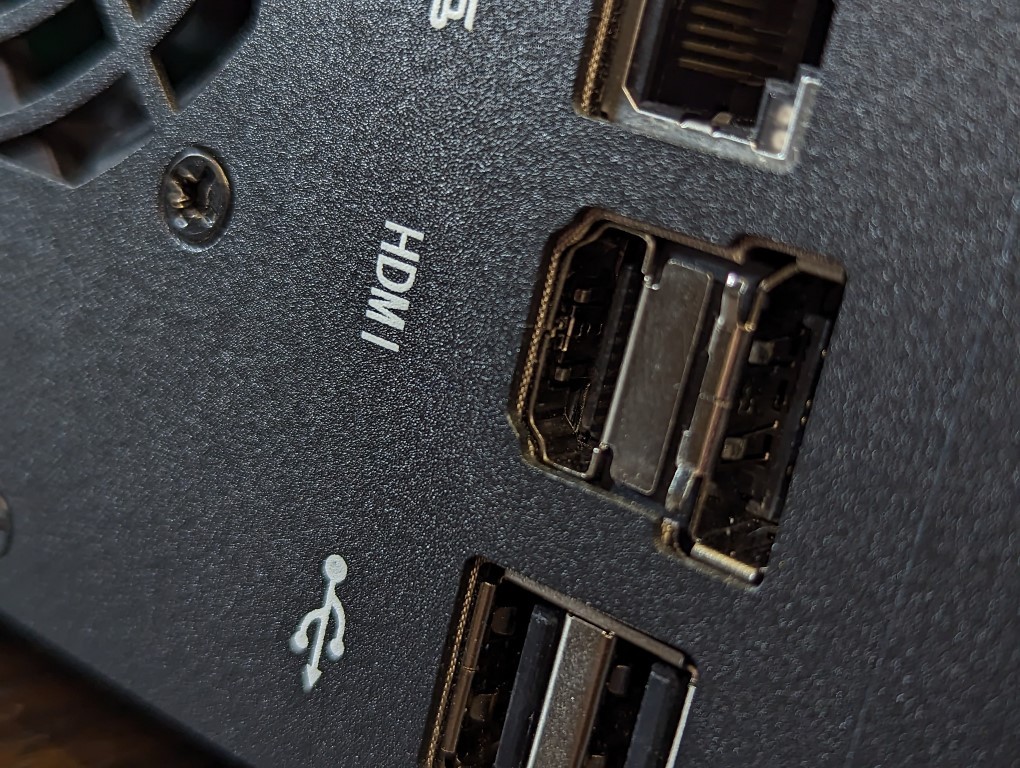
The ports and connections of the CWWK AIO-T6 NAS are clearly one of the selling points of the system, especially when you see the full range of connected boards that are available, barebones boards or complete systems from Topton over on Aliexpress (and indeed, on their own site). It’s tough to criticise the range of connections here, as for this price point, having 4x 2.5G LAN and Dual 4K output already puts it in a different scope than other NAS’s at this price point. I cannot even really complain about a lack of 10GbE scalability here as 1) the system really is stretching what its CPU/Chipset has on offer and 2) there is flexibility in the budget by looking at other devices in the portfolio somewhat mitigates this. But how about we take a closer look at that internal hardware – it’s ALOT of specs to cram in here, both at the price point AND the scale. Let’s get that lid off and take a closer look.
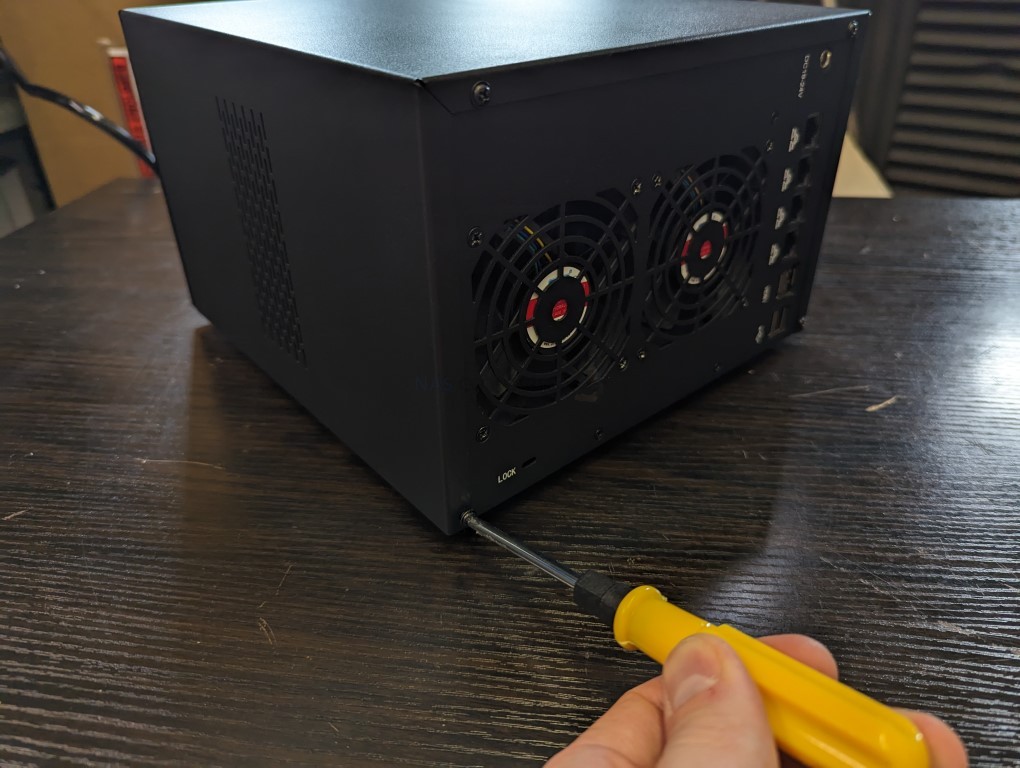
CWWK AIO-T6 NAS Review – Internal Hardware
When I say that they crammed alot under the hood of the CWWK AIO-T6 NAS, I wasn’t kidding! Using the same board/layout found here in a previous CWWK product, the AIO-T6 NAS pretty much wraps everything ‘around’ the main 6 SATA storage bays nad there is alot of loose cabling that I would have expected to be zip-tied together at least, or at most directed a little bit more elegantly around the edges of the internal casing. There are ALOT of cables to accidentally have disconnected in transit here, so I would hugely suggest checking them all before booting as only around half of them are click-lockables. I could that the SATA backplate connectors that ran into the main board backing onto the bays were all loose (bar one) leading to a false alarm during setup. Additionally the CPU does not seem to have a fan and the system is heavily relying on strategically placed heatsinks and dissipation because of this. Most NAS’ will balance heatsinks and active fans proactively (as this is a 24×7 and although heat = component degradation and bottlenecks, too much active cooling and you have dust, noise and sometimes jsut simple no space for them to go).
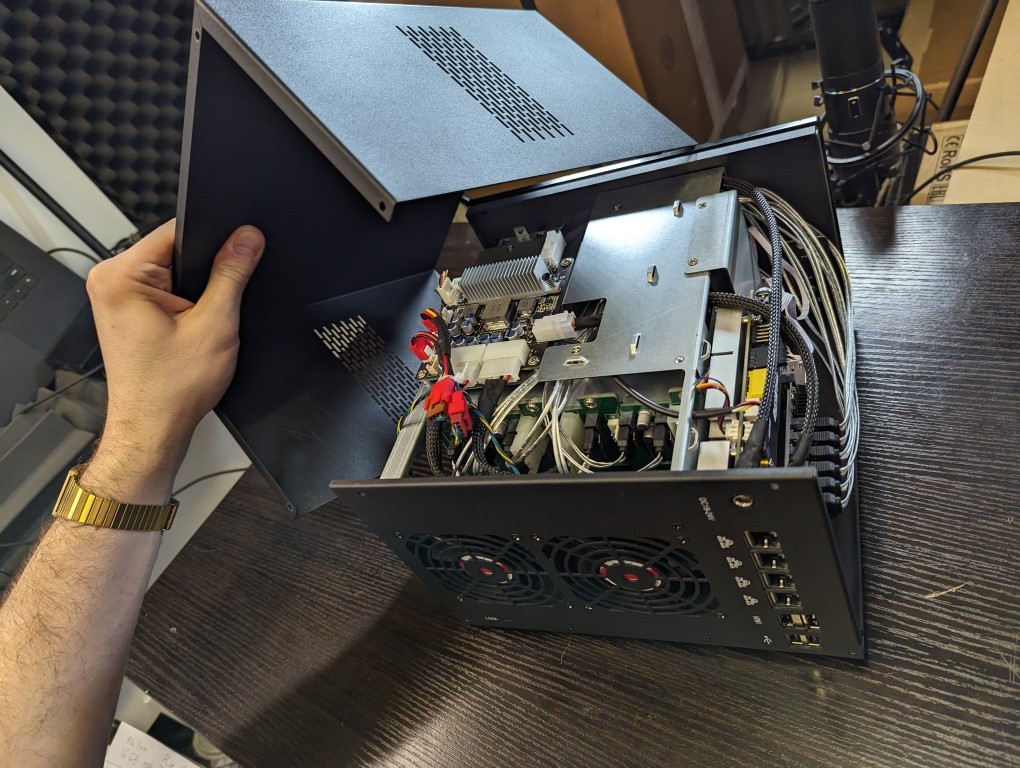
The power connector on the top right corner of the rear of the CWWK AIO-T6 NAS (bit weird) leads directly into a power cable (so, not interfaced directly into a PSU black or external PSU), which runs into a power management board/panel. Topped with its own heatsink, transistors and management chips, EVERYTHING seemingly runs out of this board and although it all seemingly works, it looks like a spaghetti mess!
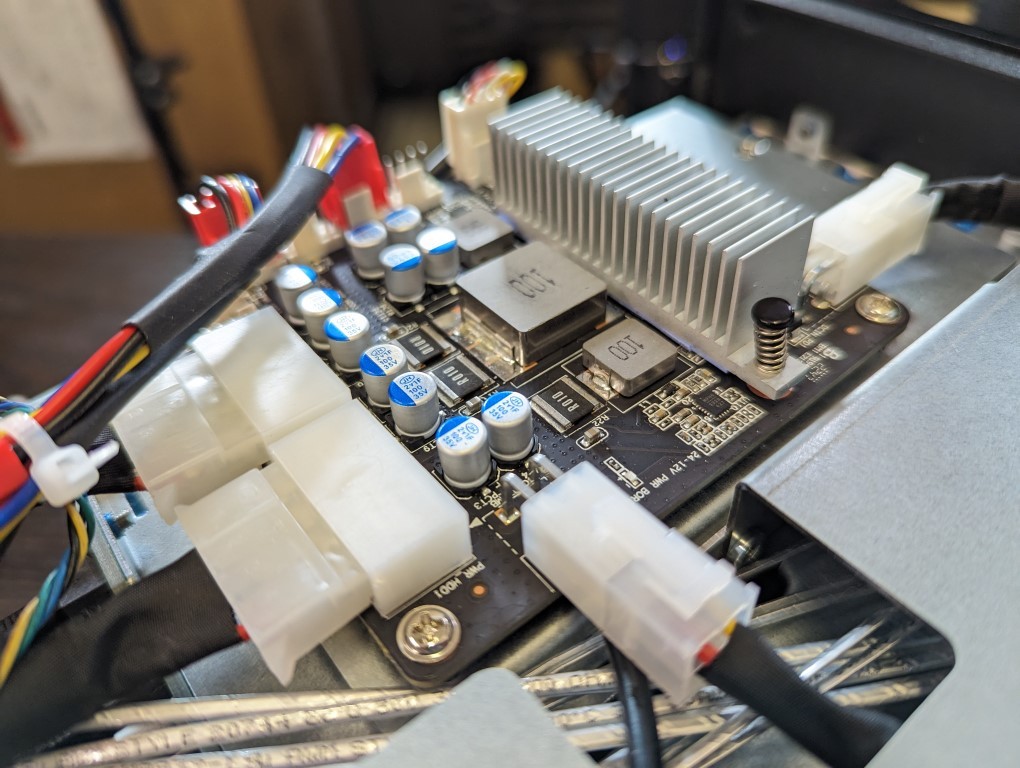
One of the main selling points of an OS-free turnkey solution like this over a full DiY is not just about saving time – but also that you are paying for someone else to do the build and paying for it to be done properly. Once again, the CWWK AIO-T6 NAS definitely works, but it looks very sketchy internally when compared against alot of premium turnkey solutions.
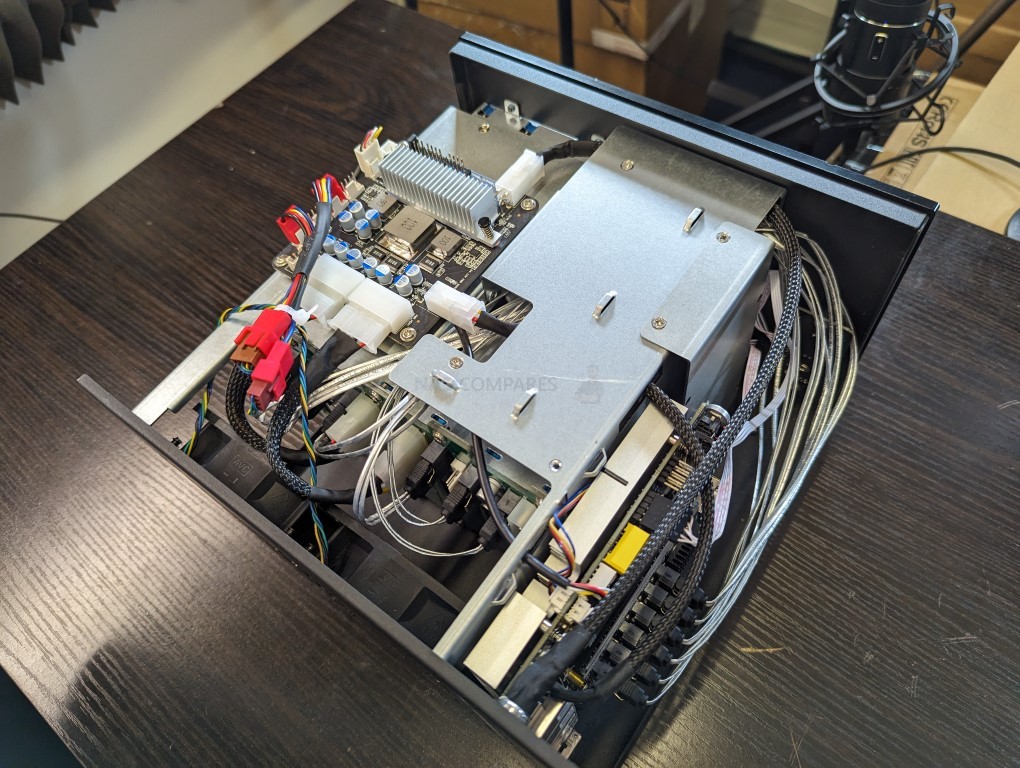
Now, one side of the internals of this enclosure is just the side of the aluminium box that houses the SATA bays. There is additional ventilation, BUT the vents of the side of the chassis are not over this area, but around 1-1.5 inches further along the casing, just about the flat aluminium panel. This is a very odd bit of airflow design and I am sort of struggling as to why. Having the vent on the top of the system, around/about the power board area, would assist in letting that heated air out, as well as allowing the air to organically flow through the horizontally placed heatsink there along the way (though it would have to travel around that clump of wires). This ven placement over the aluminium SATA bay boxing and no kind of funnelling from the vants in that available cavity seems a little odd.
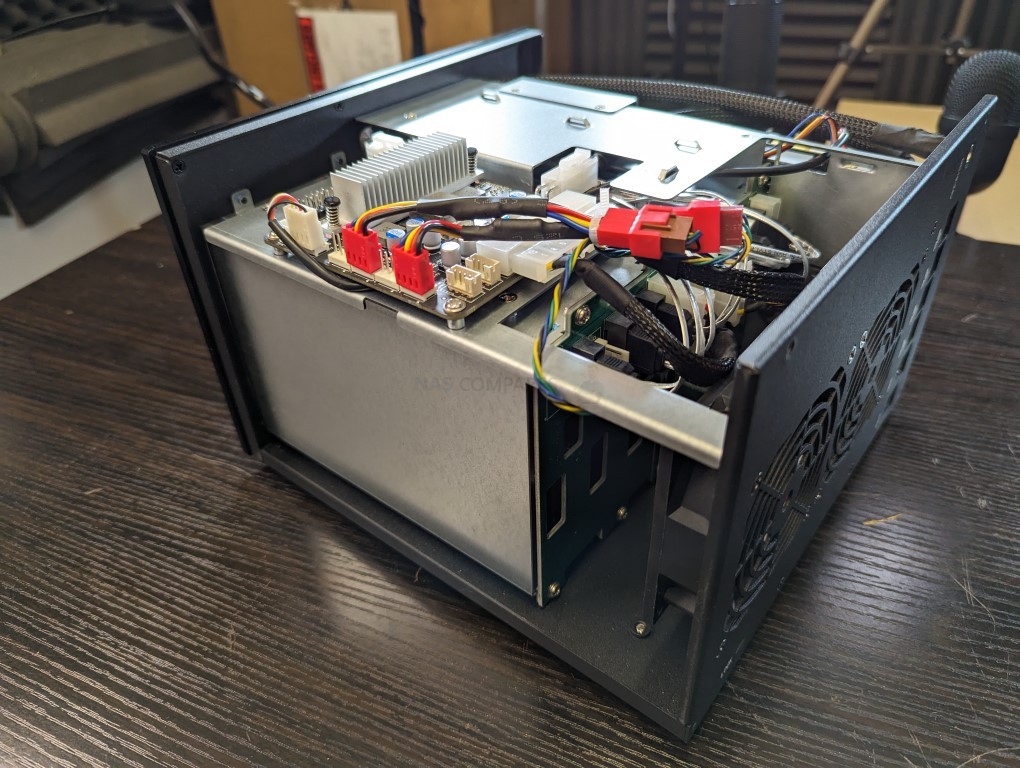
Digging a little deeper, we can look at the layout of the CPU, Memory and how the system has bridged together the storage, as to say that it has been achieved unconventionally would be an understatement. The system features two M.2 slots, a quad core intel processor, 8GB of memory that is upgradable and if you purchased the system with an SSD, it is preinstalled. However it is the way the six SATA connected drives are connected that really took me aback a bit.
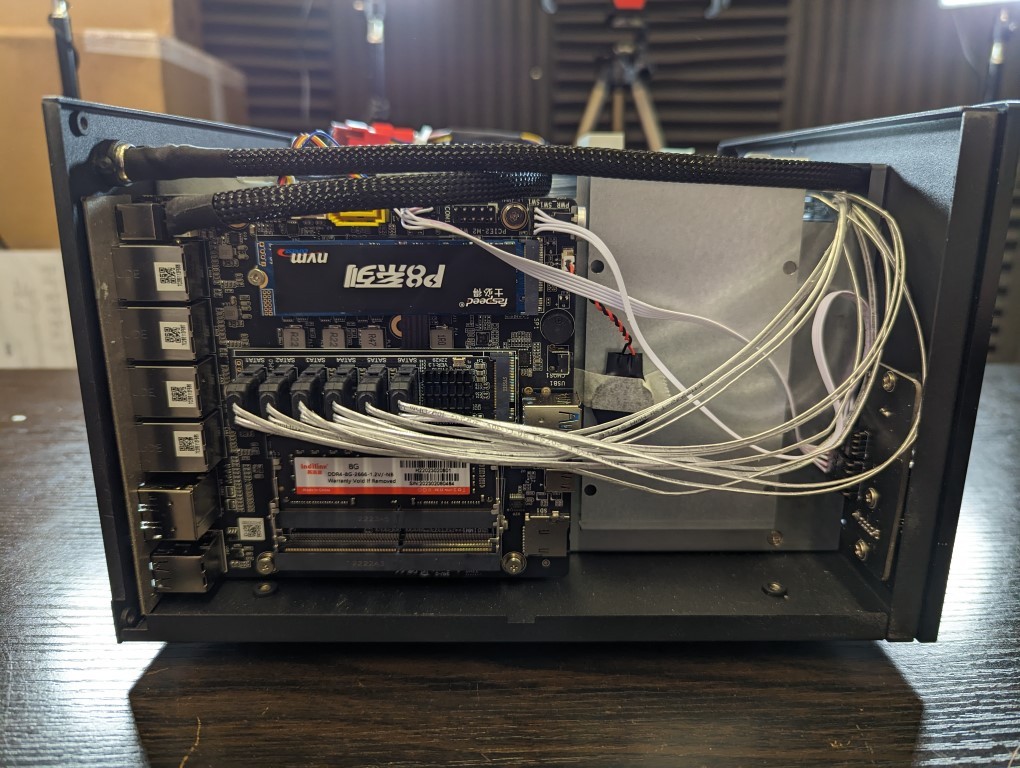
Using the UnRAID hardware management tools, I was able to find out the following breakdown of the systems architecture (this is with the Sandisk memory connected and no drives mounted). I would have pasted the whole thing, but that would have been 10-15x longer (message me if you want/need it for your own consideration):
Hardware Architecture of the CWWK AIO-T6 6-Bay NAS
Now, let’s discuss those SATA-connected elephants in the room! Now, most desktop NAS devices tend to use the same form of connectivity for a collection of SATA drives. Because of the shape/height of desktop chassis, you tend to find that the SATA+Data connectors are soldiered to a larger PCB, which in turn is connected to a main controller board (the only with the CPU+Memory+connections+etc) via a x2 or x4 PCIe connector, forming a right angle internally. Now, TECHNICALLY the 6 SATA bays in the CWWK AIO-T6 are being approached in a similar way – but not really. There is a NVMe connected (so not SATA KEY, as it only has the on cut/gap) to the 2nd available m.2 slot. This board has its own controller+heatink AND 6 individual SATA connectors, all precariously connected side by side on the 2280 m.2 sized PCB. It does NOT feel sturdy and is most of the reason for the rather ‘spagetti-fied’ nature of the internal setup.
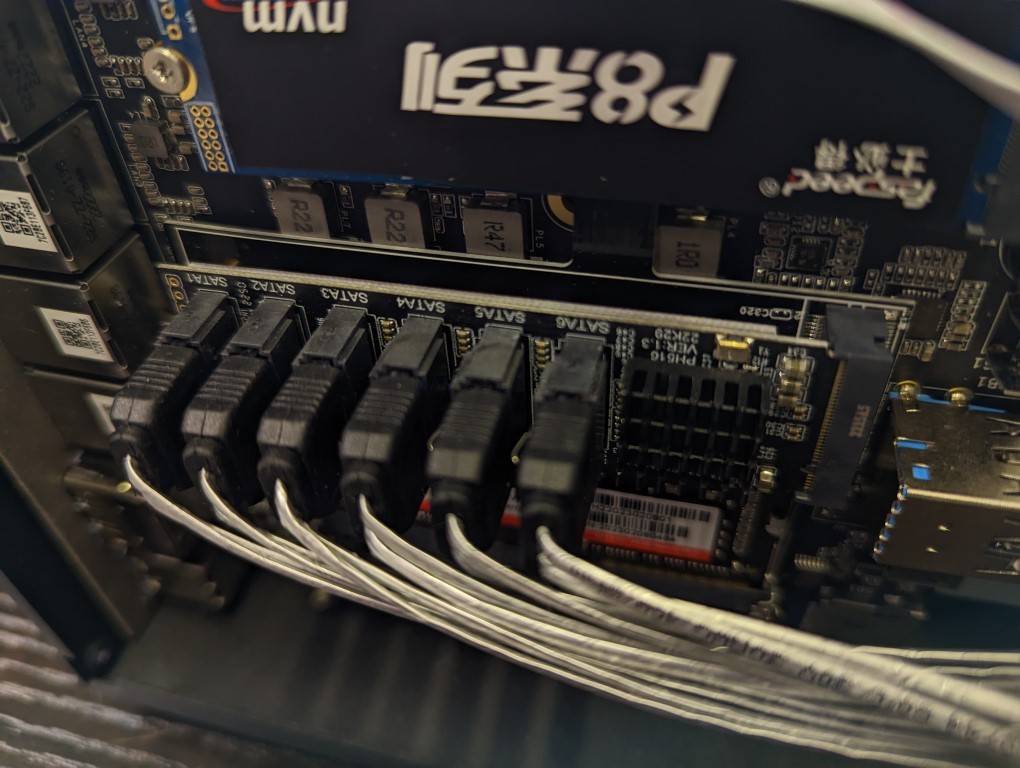
Another observation that shows that this is a general purpose mini PC board that has been used in the AIO-T6, rather than ‘designed for it’ is the fact there is both an SD Card slot somewhat hidden away, a USB Type-C Port and an additional two USB Type A ports. Even the manual Power button on the mobo is present (though that is arguably a little useful).
Having these ports and SD card slot inside, largely inaccessible for general use is such a crying waste and given they are shipping AI0-T6 with a Sandisk USB with UnRAID on it, it would have made so much more sense to have it pre-installed in one of these or on an SD Card in this slot. Even if you wanted to change the OS, it would have been no lesser choice/access than you current have right now. As you can clearly see below, this board has just been lifted from the more compact build and placed inside thos 6-Bay enclosure, with next to no refitting to the newer architecture.

Now, I won’t comment too much on the included SSD that came with the device. Aside from this being an optional extra, it’s been fairly well-established with budget builds like these that you have little control over the SSD brand or model that is included and all to oftena re either ex OEM, rebadged or even sometimes just utterly unbranded. In my case, the AIO-T6 NAS arrived with the Intel Corporation SSD Pro 7600p/760p/E 6100p Series connector and a ‘faspeed’ P8-128GJS 128GB SSD – nope, I haven’t heard of them either.
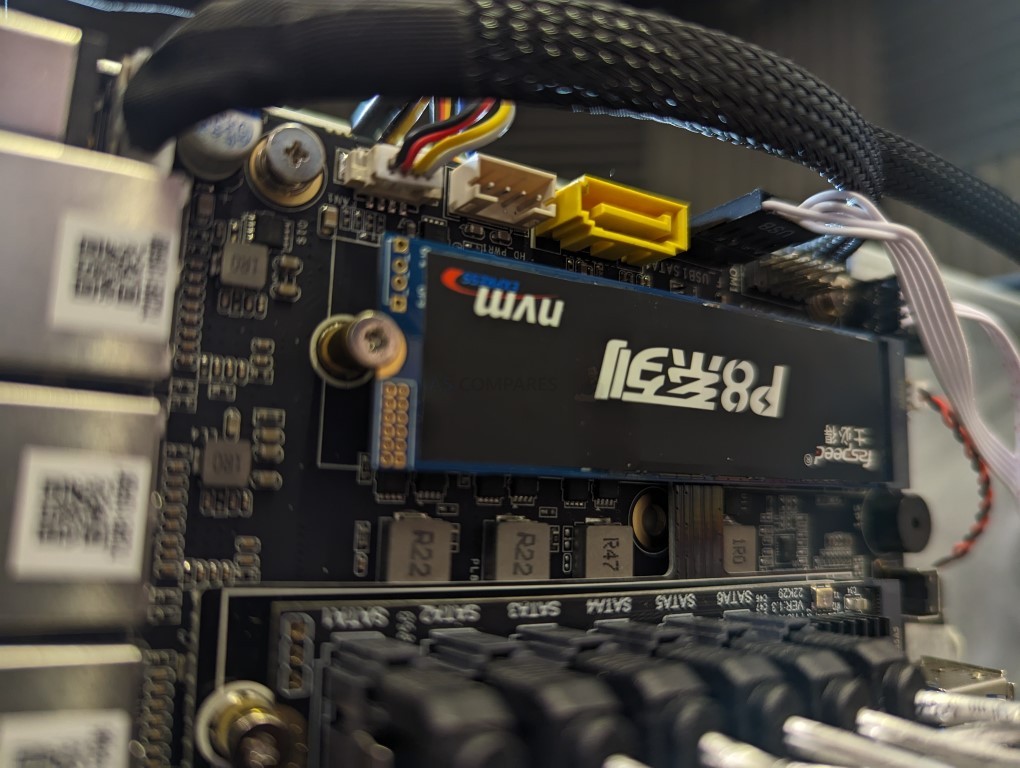
The Intel N6005 Pentium processor inside this device is still a very well-balanced CPU to arrive for this price point (especially when you factor in the surrounding hardware and ready-built structure. I am not going to criticise the CPU too much here, as this review is more about the build quality and approach of the CWWK AIO-T6 NAS, but I will highlight the heat dissipation method here. The N6005 processor here has no CPU fan (not unusual in a desktop NAS of this scale), instead favouring huge heatsink that covers the bulk of the other side of the controller board. In the original Mini PC build from CWWK that uses this controller board (again, see the image from their site above) you can see that the roof of the mini PC was one giant heatsink. As this board has now been stuffed inside the 6-Bay casing, it has immediately lost all that passive airflow that the external design of the heatsink provided in the previous design. Instead, now we have a CPU with a giant heatsink, that is sandwiched behind the SATA storage box and even when the rear fans are passing air through the vents of the CPU heatsink, it is not entirely clear where that air is going to go!
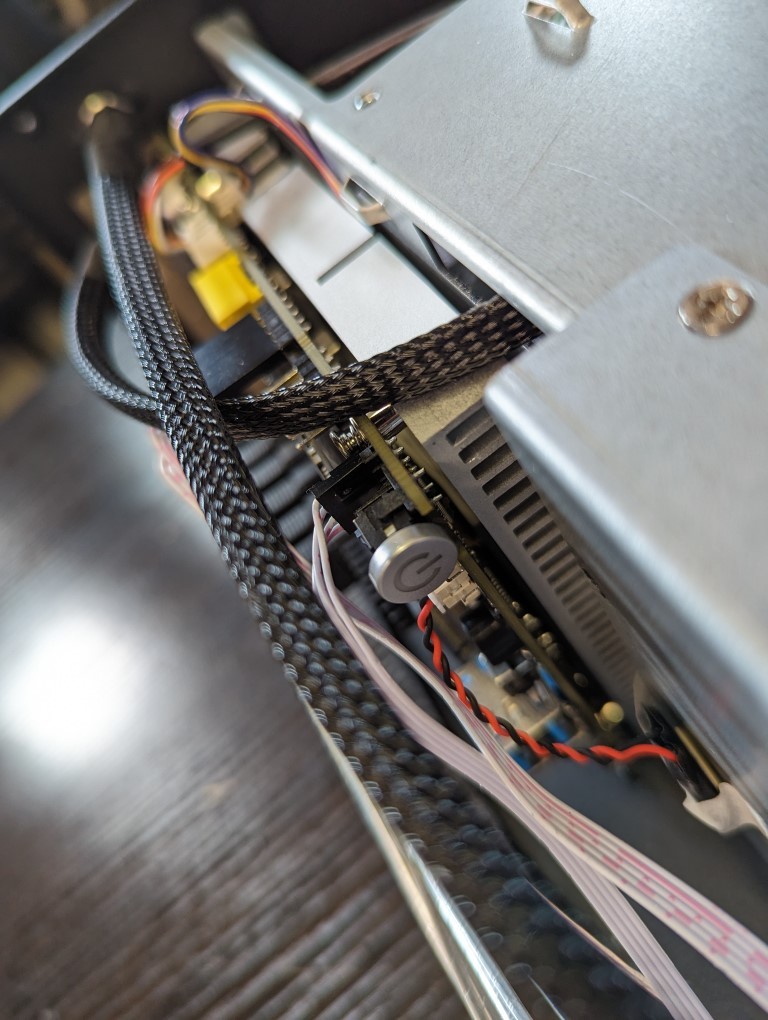
The choice of Intel N6005 CPU inside the CWWK AIO-T6 NAS IS a good choice and with so many NAS brands favouring Intel Celeron’s at this scale for their SOHO/SMB systems, it is certainly a breath of fresh air to see a Pentium here (even a reasonable aged Gen, with a burst speed upto 3.3Ghz). A quick check on CPUBenchmark shows it at almost double the rating of the N5105 and J6412 being used by similar scale QNAP and Asustor NAS’. So, although they could have just gone with an Intel N5105/J612 like many others, there is clear choice of a good CPU here for the price.
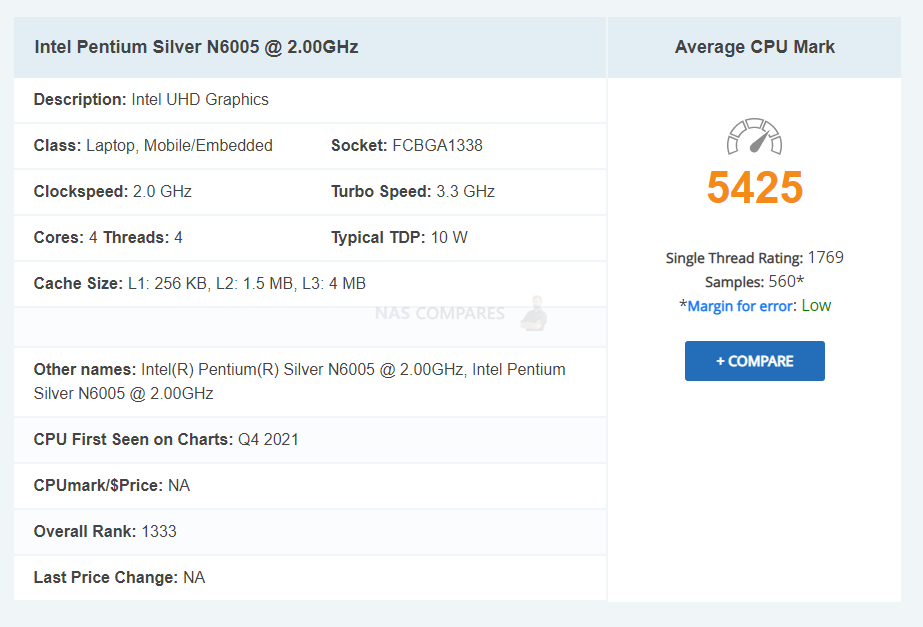
Add to that the integrated graphics of this processor are a cut above those found in the Synology DS423+, QNAP TS-453E, Terramaster F4-423 and Asustor AS6706T so that you will have a decent level of integrated graphics for your lite VMs, containers, Multimedia servers like Plex & Jellfin, etc.
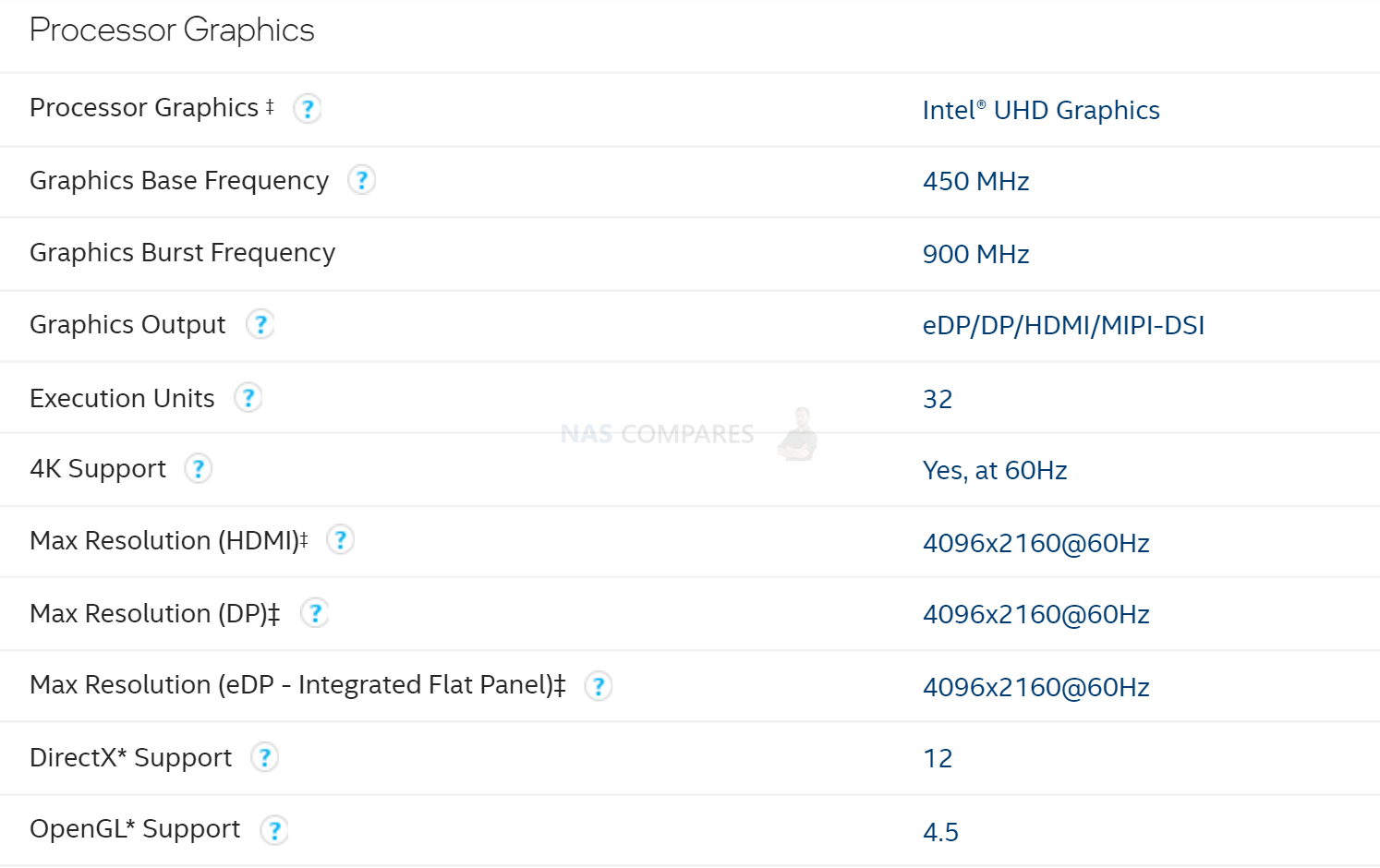
Again, I won’t be overly critical about the memory inside. The system can be purchased without memory included, with 8GB of DDR4 SODIMM 2666Mhz included for a few quid. It arrives as a single 8GB module and although I would give them credit for not using 2x 4GB to cut corners, this is more likely down to the increased shortages on memory and it just is easier to go for a single memory stick with increased cell capacities for cost. (the same reason why we are starting to see alot of NAS devices arrive with either fixed memory OR are arriving with 4/8GB out the gate like the TS-264 or TS-453E). Another brand I have not heard of, ‘Indilinc H22’ memory, but I did a memory test in UnRAID and it passed fine.
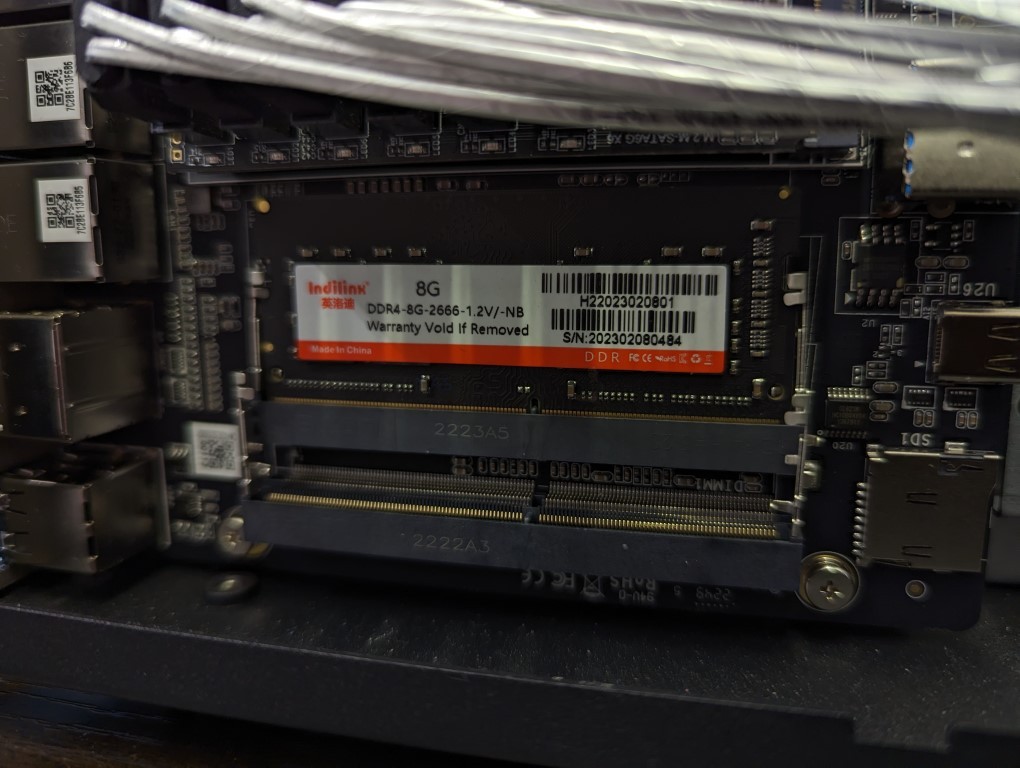
I have so many mixed feelings about the internal hardware of the CWWK AIO-T6 NAS. On the face of it and glancing at the spec sheet, there is no arguing that you are getting ALOT of hardware bang for your buck here. However, the way it has been crammed inside, the rescue of the main board that has left alot of internal wastage, the odd m.2-to-6X-SATA PCB is a bit sus and that heatsink placement on the main board is borderline abusive! Also, when it comes to noise (GO TO HERE IN THE VIDEO TO HEAR GENERAL SYSTEM NOISE) it is NOT a quiet system and regardless of whether you use the included UnRAID software OR you switch to TrueNAS or OpenVault etc, it is definitely going to get warm in there. Overall, I like what I am seeing in terms of spec, but I do NOT like how it has been put together. It makes ALOT more sense when you see this layout/architecture in the smaller mini PCs from both CWWK and Topton (arguably the same thing from a consumer standpoint), but the modification of this in the 6-Bay casing has not been done especially well.
CWWK AIO-T6 NAS Review – Conclusion & Verdict
As a middle ground between turn-key NAS that force you to pay for H/W+S/W, or going full DiY from the ground up with open-source, the IDEA of the CWWK AIO-T6 NAS makes alot of sense. You are getting a ready-to-switch-on piece of 24×7 server hardware in desktop form, that arrives with better hardware than every other NAS solution at that same level, but 40-50% cheaper! For those users who are time-rich but money poor, this does offer another option beyond building from scratch when you might not have the skills to build, but you have the time to learn one of many different open-source software alternatives. In that sense, we need to see this area/tier of the storage industry get bigger and more populated. However, the CWWK AIO-T6 NAS is not the best example of this and, in many ways, actually makes the likes of Synology/QNAP/Asustor/Terramaster more palatable, simply by reason of a cleaner, better constructed and presented internal construction. There ARE some great examples of OS-free NAS servers available right now (not just scrappy ones on Aliexpress, but actually formidable alternatives that have grown from mini-PCs to real servers for home/SMBs), but the CWWK AIO-T6 has too many elements internally where they have clearly taken the internal hardware kit of existing stock and repurposed it in inelegant ways. I do think we are going to start to see some really interesting open-source ready-built NAS systems start to roll out in this burgeoning area of the desktop NAS industry (especially as globally, people are going to be a tad more selective about their spending), but the AIO-T6 is not the best example of this. I recommend going for the Topton/CWWK Mini PCs with the same board, but better utilized and presented.
 |
|
| CWWK AIO-T6 PROS | CWWK AIO-T6 CONS |
|
|
Need More Help Choosing the right NAS?
Choosing the right data storage solution for your needs can be very intimidating and it’s never too late to ask for help. With options ranging from NAS to DAS, Thunderbolt to SAS and connecting everything up so you can access all your lovely data at the touch of a button can be a lot simpler than you think. If you want some tips, guidance or help with everything from compatibility to suitability of a solution for you, why not drop me a message below and I will get back to you as soon as possible with what you should go for, its suitability and the best place to get it. This service is designed without profit in mind and in order to help you with your data storage needs, so I will try to answer your questions as soon as possible.
📧 SUBSCRIBE TO OUR NEWSLETTER 🔔 This description contains links to Amazon. These links will take you to some of the products mentioned in today's content. As an Amazon Associate, I earn from qualifying purchases. Visit the NASCompares Deal Finder to find the best place to buy this device in your region, based on Service, Support and Reputation - Just Search for your NAS Drive in the Box Below
🔒 Join Inner Circle
Get an alert every time something gets added to this specific article!
Need Advice on Data Storage from an Expert?
Finally, for free advice about your setup, just leave a message in the comments below here at NASCompares.com and we will get back to you.
 Need Help?
Where possible (and where appropriate) please provide as much information about your requirements, as then I can arrange the best answer and solution to your needs. Do not worry about your e-mail address being required, it will NOT be used in a mailing list and will NOT be used in any way other than to respond to your enquiry.
Need Help?
Where possible (and where appropriate) please provide as much information about your requirements, as then I can arrange the best answer and solution to your needs. Do not worry about your e-mail address being required, it will NOT be used in a mailing list and will NOT be used in any way other than to respond to your enquiry.
TRY CHAT
Terms and Conditions


ZimaOS is the BEST Beginner NAS OS - Watch Your Back UnRAID and TrueNAS !!!
30TB Hard Drives are TOO BIG ! (and here is why)
COMPLETE UGREEN NAS Setup Guide - 2025 EVERYTHING VERSION
$110 USB4 to 2x10Gb Adapter Review - What the WHAT?
UGREEN NAS Now has iSCSI, 2FA and Jellyfin (and more) - FINALLY!
Seagate 30TB Ironwolf and EXOS Hard Drive Review
Access content via Patreon or KO-FI


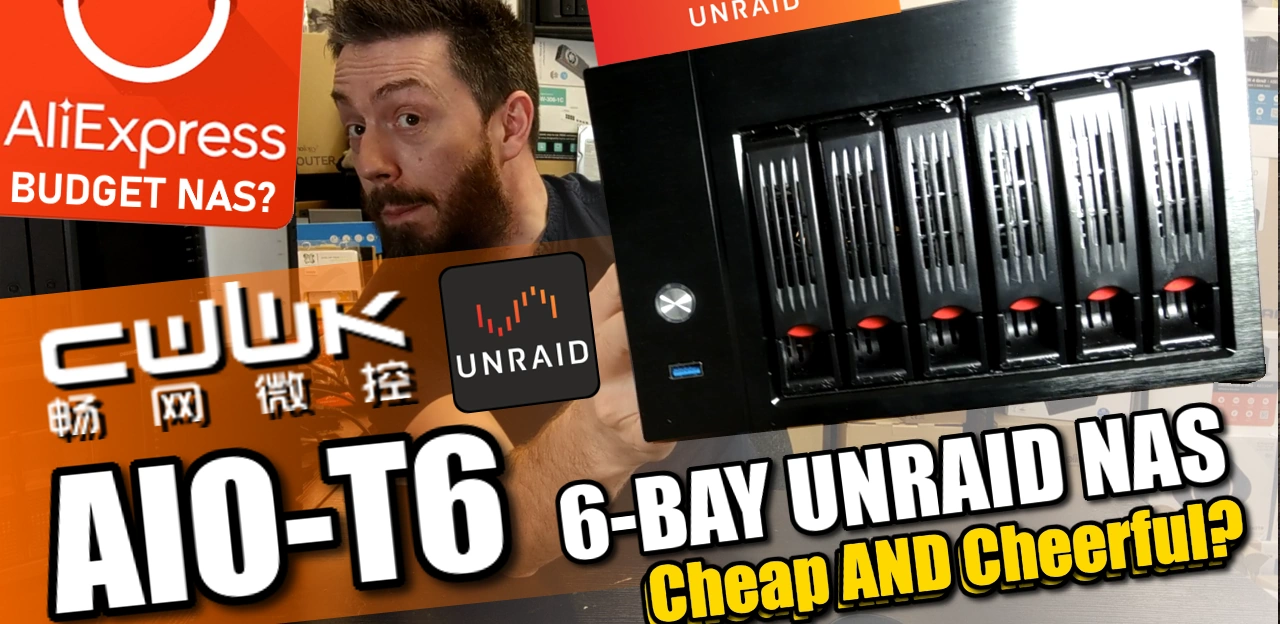
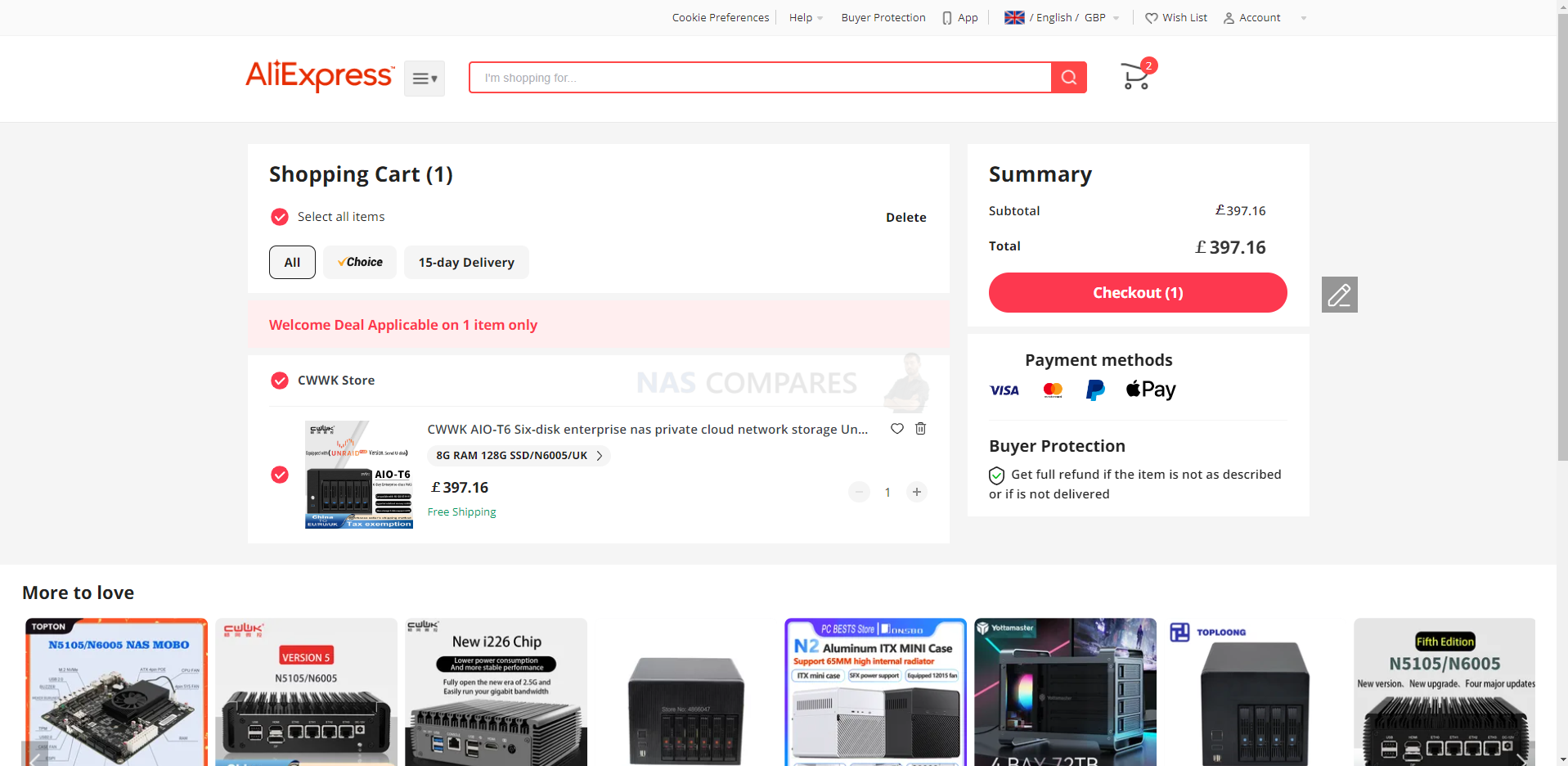
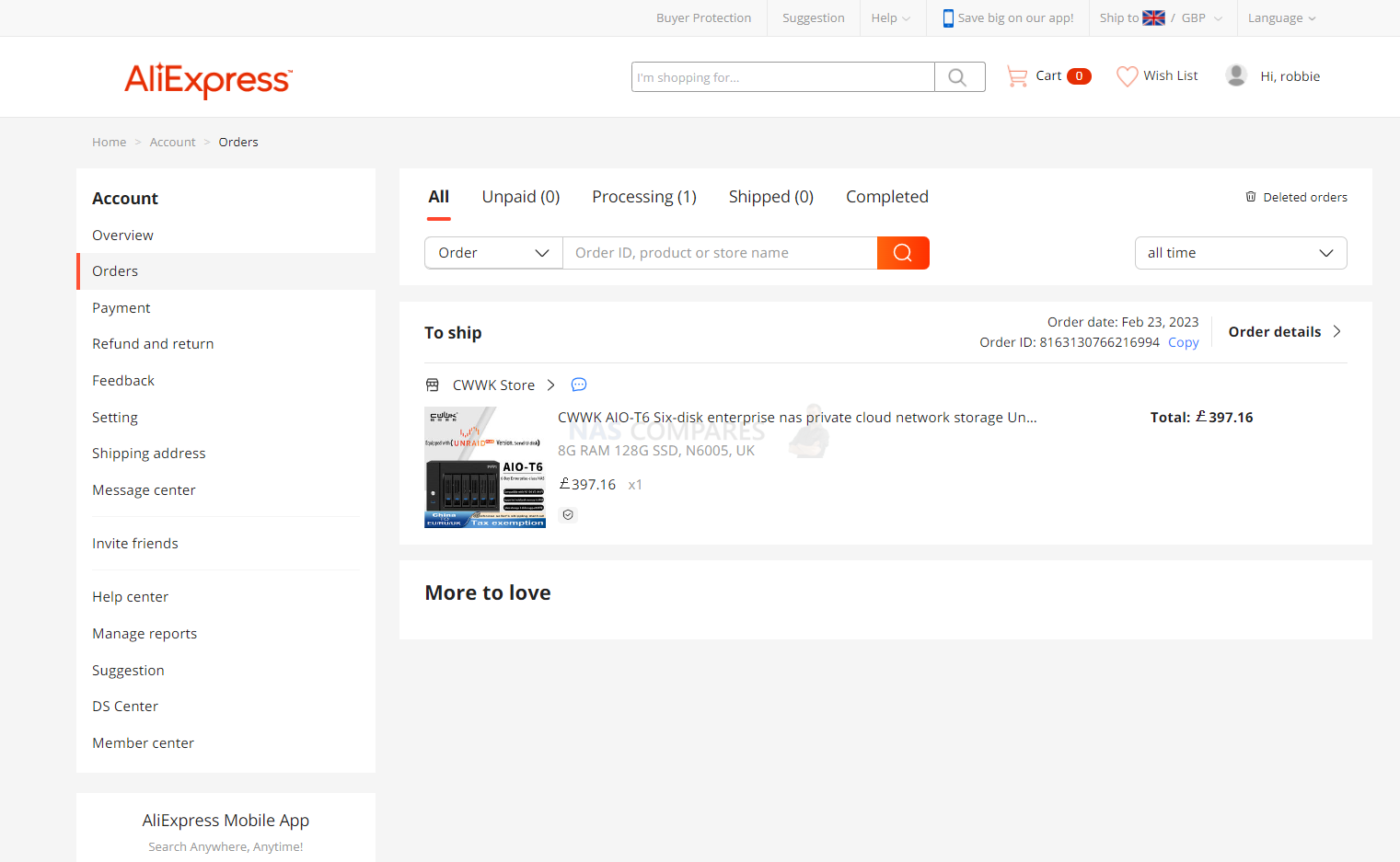
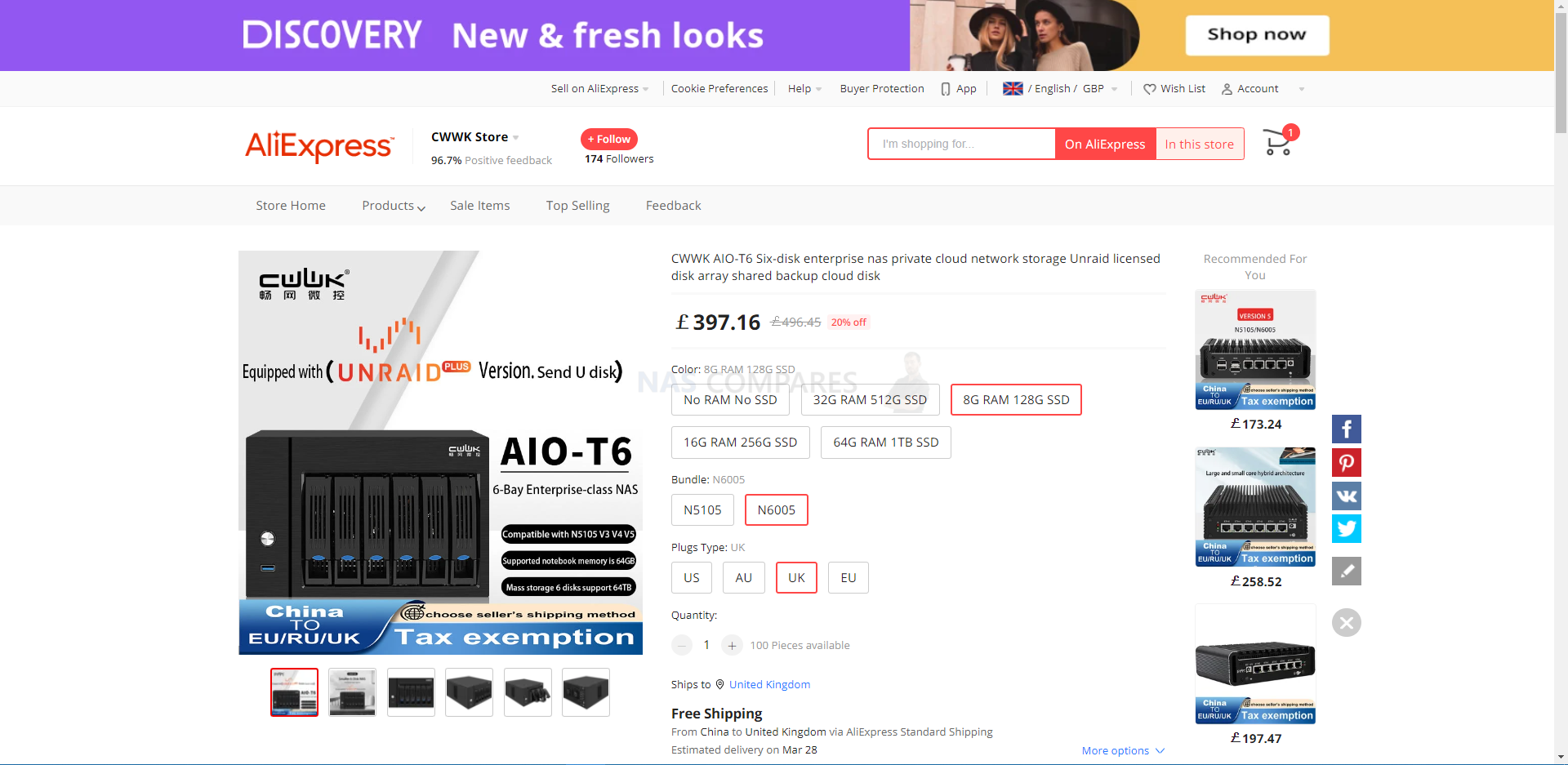
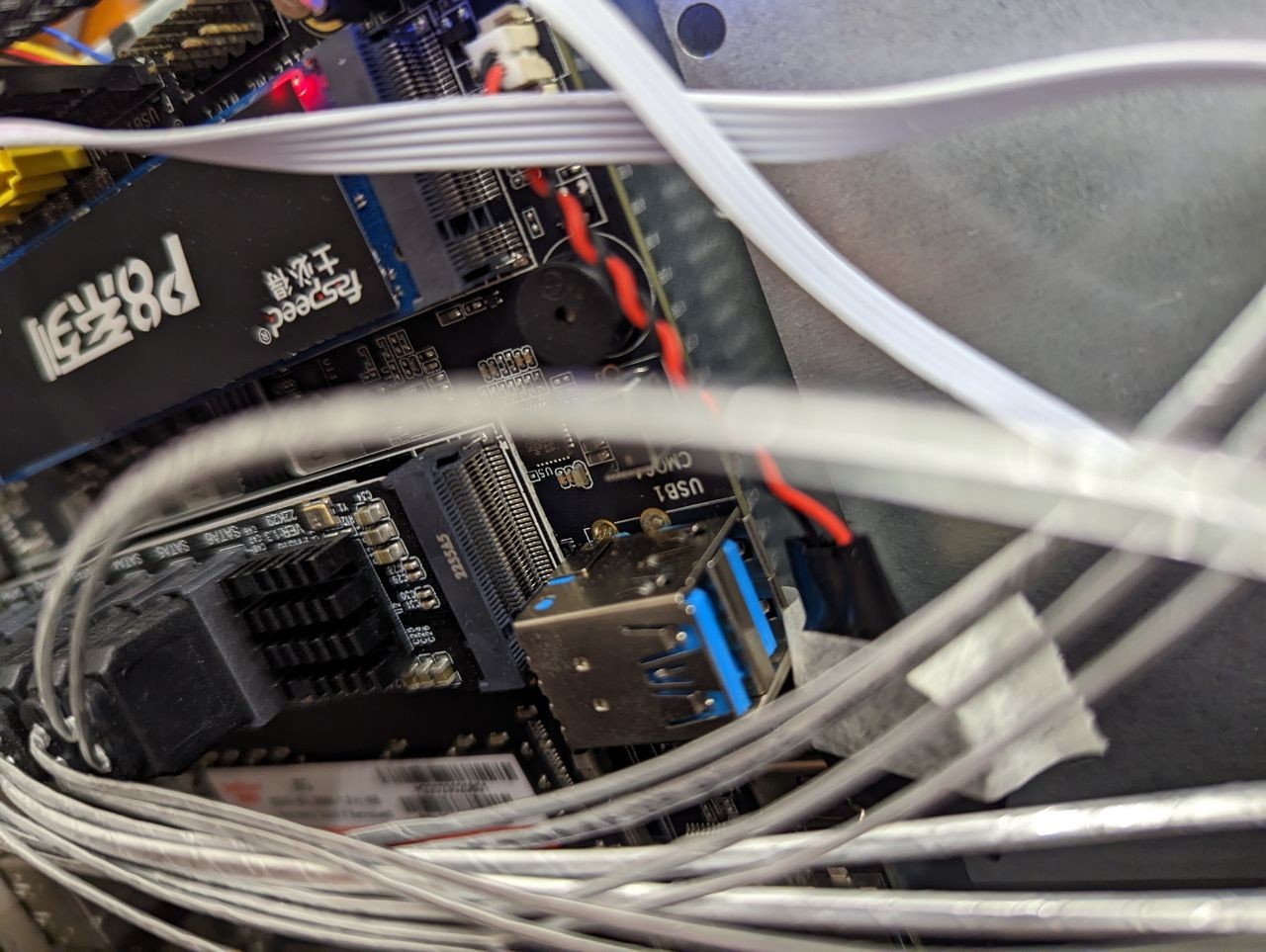
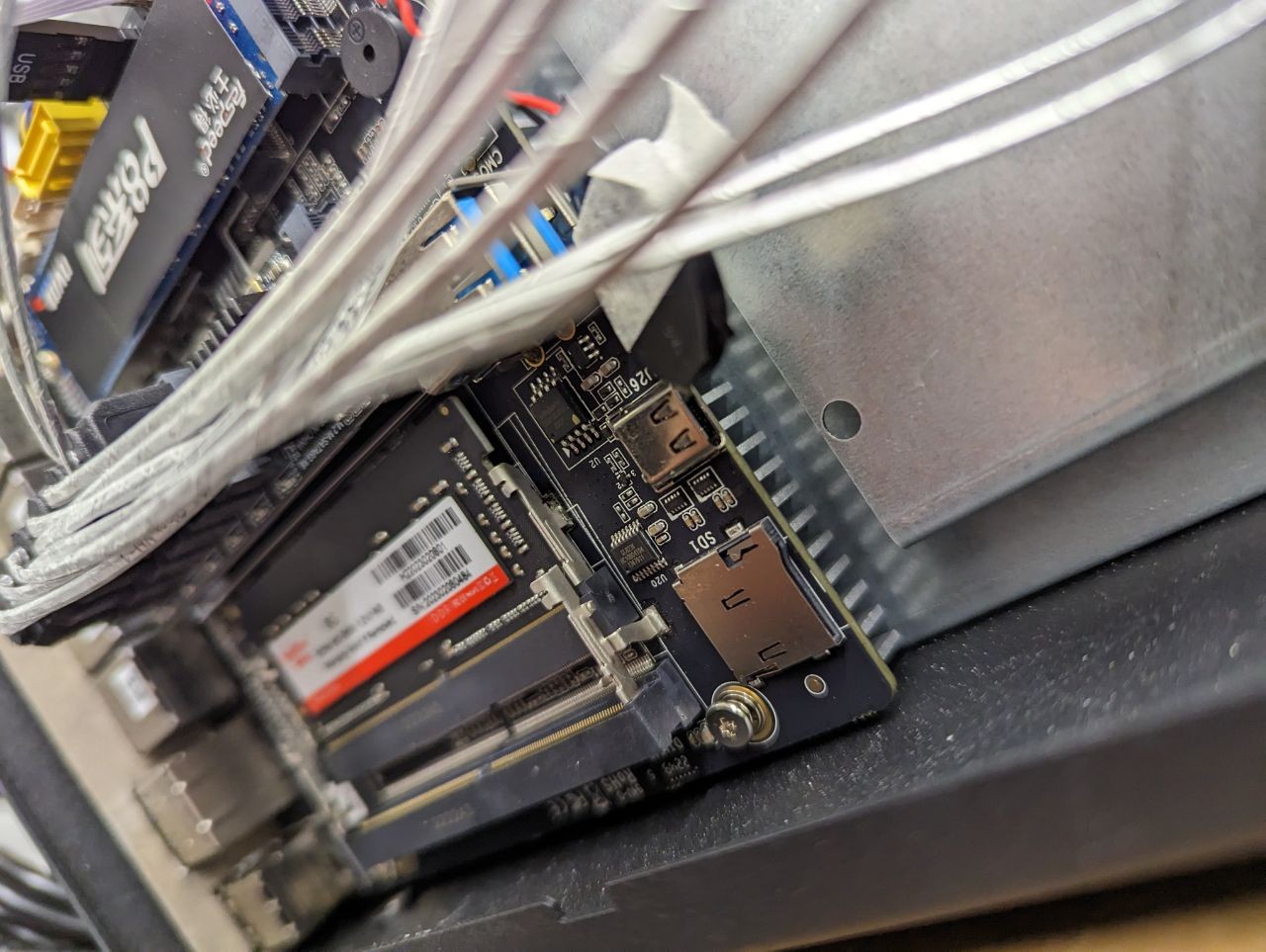
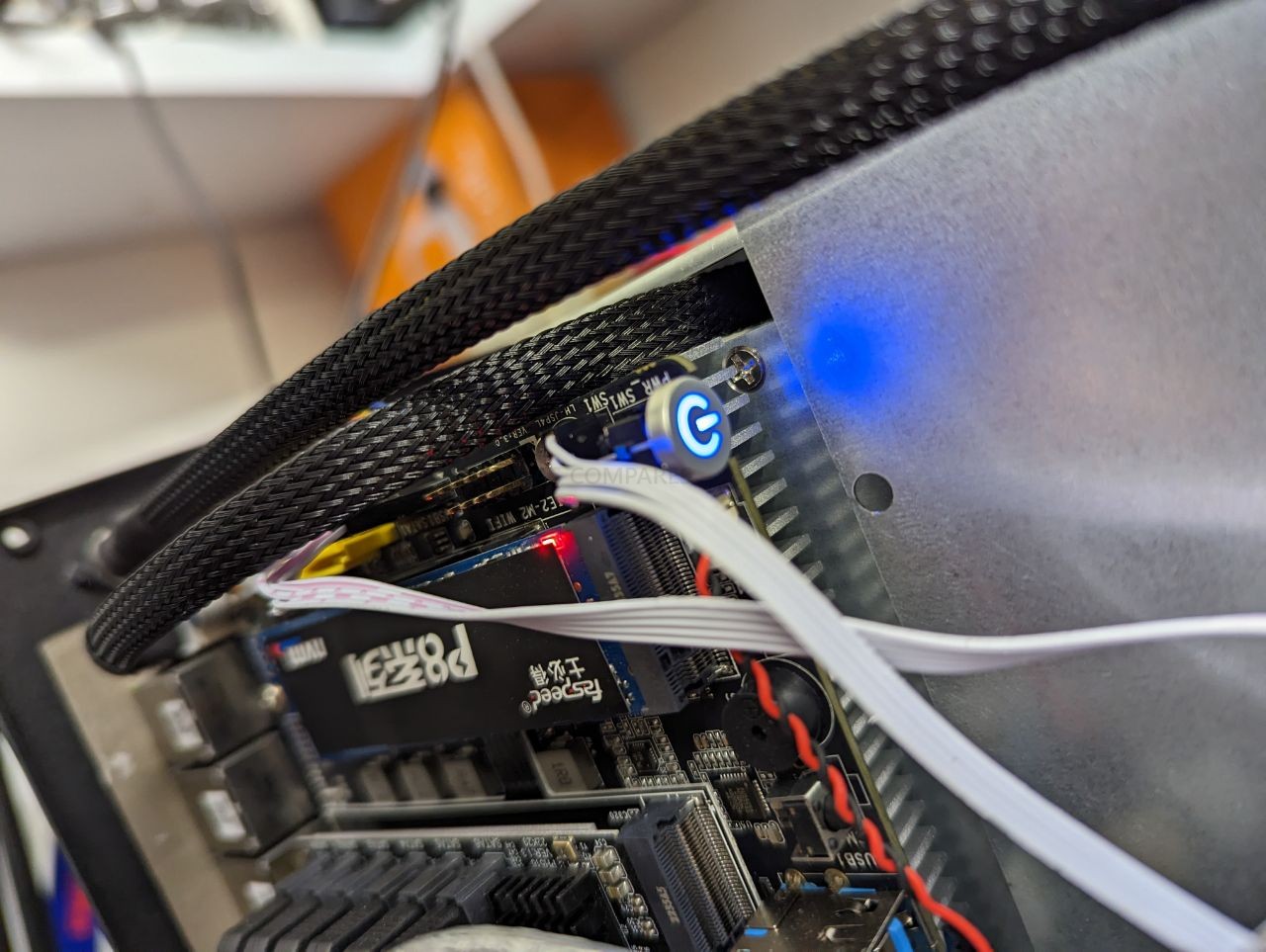




If I can make a recommendation, instead of turning the device back and forth as you look at it, post a static picture so we can look at it as you’re talking about that area..
REPLY ON YOUTUBE
Hi, you did a Great in-depth look on storaxa through Kickstarter, and I was wondering if you knew anything more than the average reply on Kickstarter as of March 2024 or is the fact too good to be true just the fact people have lost on this one. Your comments would be appreciated.
REPLY ON YOUTUBE
StoraX… Reminds me Netgear Stora, old pain in my ass, 2-bay NAS. Problem with this device in discontinued support from Netgear. They have disabled the servers from where the firmware and configuration for the device should be downloaded. If you reset the settings for your storage, then congratulations, now you just have a black cube for hdd storage.
REPLY ON YOUTUBE
it’s a SCAM..sadly (i am a backer)
REPLY ON YOUTUBE
Thanks for this review. I was looking at the CWWK J6412 as it has a beautiful case. It likely has a similar motherboard. As soon as I saw all 6 drives going to 1 pci adapter, I knew it would be slow
REPLY ON YOUTUBE
I’d rather have 1 10Gbe than 4 2.5s 2.5 is such a waste. Why it even exists makes no sense
REPLY ON YOUTUBE
Great video, would love to see you do a DIY Nas build. I’m curious to see what case and parts you would use also the OS . I’m not a fan of the these big brands everyone seems to be pushing for whatever reasons
REPLY ON YOUTUBE
CWWK appears to have newer (??) revisions of the AIO-T6 with a vertical HD drive layout – 3 above and 3 below. One has a J6412/J6413 CPU and a different layout of 2.5GbE ports – 3 Intel and 1 Realtek – so the motherboard would be different than the recycled one shown in this video. The pictures also show a top cutout and a description that says you can add a PCIe expansion card. I find that claim rather dubious.
REPLY ON YOUTUBE
I hope this isn’t a security issue like WD my cloud
REPLY ON YOUTUBE
Great video. I’ve always been wondering how the box looked inside. MAny thanks!
REPLY ON YOUTUBE
Thanks, we can’t all stretch to the expensive units so this is very interesting!
REPLY ON YOUTUBE
Hi guys, i need some help from you.
I’m thinking of replacing my Qnap-NAS with the Synology DS1621xs+. However, i have a hardware related question you might be able to help me with: I’m thinking of putting Samsung PM893 SATA-SSDs (8TB) in it since there is a special deal here at the moment. I would be very glad, if you could tell me, if they make sense in this NAS (also for Raid F1)? …and if you see any problem with using the Samsungs over Ironwolfs and WD Reds (i don’t really need that many TBWs for my use case –> mosly Plex Server and for Backups)?
Thank you in advance!
REPLY ON YOUTUBE
Fantastic content.
Regarding this being a new brand.
Choice is always a good thing.
I am excited for the next chapter.
REPLY ON YOUTUBE
*Just a quick follow-up to this video on the CWWK AIO-T6 NAS Review, I just finished the big write-up on it. There are tonnes of close-up photos of the rather odd approach to the layout + new observations since that video was recorded on how the internal hardware was repurposed + that odd m.2-SATA bridge and the spaghetti cabling! Read more about it here in the
CWWK AIO-T6 6-Bay NAS Written Review. Bang For Buck? – https://nascompares.com/2023/03/24/cwwk-aio-t6-6-bay-nas-review-bang-for-buck/
Have a fantastic weekend everybody!
#datastroage #nasdrives #budget #happyshopper
REPLY ON YOUTUBE
Unraid, is NOT open source. Their website states it is a proprietary software solution. Personally I would never use it.
REPLY ON YOUTUBE
Zero percent chance of using Unraid just climbed to 1%, given it was included…
REPLY ON YOUTUBE
The device on aliexpress now looks like a redesign of this
REPLY ON YOUTUBE
The tape man is still doing a good job
REPLY ON YOUTUBE
Because of unraid. It has at least one usb2 point because 3.0 makes problems because of heat. And Unraid is build to run from ram and USB stick can backup online if you like and the licence can be transfered to another USB stick
REPLY ON YOUTUBE
please publish in 4K for a better assessment of products!
REPLY ON YOUTUBE
Apparently the heat is perfectly normal Robbie. It’s actually just a 4 bay NAS. Those two slots on the right are sandwich warmers…
REPLY ON YOUTUBE
problem with something like this is that saving a few hundred quid upfront will then leave you with years of uncertainty as to whether its going to one day melt and destroy all your data and a grands worth of hard drives. If I can’t trust it then why bother with it being 6 bay? I would maybe find a use for it as a two bay for media storage or maybe a redundant backup but even then I would still maybe be more tempted to buy a used branded product off ebay.
REPLY ON YOUTUBE
Storaxa is TrueNAS Scale
REPLY ON YOUTUBE
You put this out about an hour ago so naturally it’s no longer available. Doh!
REPLY ON YOUTUBE
I was actually expecting it to be more of a flaming piece of trash. It’s actually serviceable for what, £300? For the hardware, that’s not terrible.
REPLY ON YOUTUBE
Like the new transitions
REPLY ON YOUTUBE
LoL the Chinese QC certificate could say… “this unit fails, is broken, missing parts and damaged. QC FAIL” Also plugging some random SD-Card from China into anything that you trust with your data… ????????????
REPLY ON YOUTUBE
Unraid is designed to boot and run from USB. It was never designed to be installed on internal storage.
REPLY ON YOUTUBE
Pretty clever how they used a motherboard they had already, and put in an adapter to convert one of the M.2 PCIE slots to 6x sata!
REPLY ON YOUTUBE
There doesn’t seem to be any direct external venting for the CPU cooler, assuming it’s actively cooled.
Why bother pulling the wool with an unlicensed UNRAID install, when they could have gone down the TrueNAS route?
REPLY ON YOUTUBE
Making money is action. keeping money is behavior. Growing money is knowledge. I’m excited I started earning upto 15thousand dollars extra income.
REPLY ON YOUTUBE
Their Aliexpress store is over capacity!
REPLY ON YOUTUBE
That is a typical packaging for anything from Asia.
REPLY ON YOUTUBE
Doesn’t Synology already have a router, access point, and “NAS” in one box? The drive is not internal, but attached as a USB drive. I presume the external drive can be a two-drive enclosure with RAID1 configuration.
REPLY ON YOUTUBE
I took a risk, I’ll let you know the results in the coming days
I’m looking forward to the result
REPLY ON YOUTUBE
haha i backed it up, if i found your video before, i think i will not have done it. I can report what happened. But i backed a lot of kickstarter campaigns, i never failed until now 🙂
REPLY ON YOUTUBE
A NAS with a 12th gen CPU and Iris XE is what I always wanted
REPLY ON YOUTUBE
I am a backer, but I do have doubts and at least match my hopes for this project, but I do like the fact you’ve chucked your hat in the ring for the sake of the community – bravo, sir.
If we all get scammed together, well… misery loves company.
REPLY ON YOUTUBE
Note. I have made a follow up video to this explaining this video, addressing some corrections and discussing how/why some subs were asking me about this innovative project – https://youtu.be/RQEb02PKgSA
REPLY ON YOUTUBE
Well, new update from Storaxa with sme new videos…
How you feeling about the project now…
Loving goal #5 I must say, everyone loves a free 32gb mSD card lol
REPLY ON YOUTUBE
I remember seeing some more critical (yet not offensive) questions and comments, they all seem to be removed by KS or at least I can’t find them anywhere.
REPLY ON YOUTUBE
Hah, this just happened: “Your pledge for Fully Customizable Home Cloud Storage with Remote Access NAS has been canceled
Our Trust & Safety team reviewed a request to remove you from this project. Your pledge has been canceled, and you won’t be able to back it again. ”
So Soraxa complained and asked to be removed. If you wanted more signs…
REPLY ON YOUTUBE
Reading all the comments here feels amazing , great community
Im a backer and love the idea of an extra NAS company, but I think that this project is going a tad above their heads, they mean well but high risk of failing
REPLY ON YOUTUBE
Sounds like they know someone who knows someone who can slide those motherboards out the back door for cheap. sounds good to me! LOL They also claim to have a boatload already….
REPLY ON YOUTUBE
2*8GB of RAM??? TrueNAS alone really need more for 100TB of storage…
REPLY ON YOUTUBE
Seems legit to me based on what’s available currently
REPLY ON YOUTUBE
100tb only? Too small
REPLY ON YOUTUBE
I’m interested to know how iX Systems feel about these things, I would have assumed they can foresee a lot of support calls for basic issues that are not their responsibility. If you buy a TrueNAS system from iX Systems, you get some support included and then you can pay for it. I’m curious what support package this kickstarter is proposing. When there’s more CGI models than actual physical models, I’d be concerned.
REPLY ON YOUTUBE
Only a really minor point, but if you can use an external hard drive for additional game storage for PS5’s, a NAS ‘could’ do it too. I don’t have direct experience of this with PS5’s, but it can be done with PC games. Like you say though, the user needs to be proficient at config and it appears marketed at non-tech users, which is a conflicted situation!
It’s done via iSCSI / ZVOL in TrueNAS, it isn’t a turnkey setup though.
REPLY ON YOUTUBE
ive really been looking for something like this ,
and i did back this on the 2nd tier before the possible upgrades ,but pulled my pledge last week,
if it does get fulfilled it’ll be a winner ,especially on home lab front
but will put my pledge towards a self build with a fractal design case ,so if anyone has suggestions on a mitx board ?
also in the video it was mentioned terramaster can run truenas ,is this via their software or can i wipe and load proxmox – truenas -pfsense?
REPLY ON YOUTUBE
They’ve replied to the comments in your video, then, oddly, a ‘Superbacker’ says the following
‘Storaxa be careful! In the video they admit it is a competitor that asked them about the campaign and they spend some time to praise the product of that competitor. There is definitely a hidden agenda here. They get commission from sales with the links in their videos. You may need to advertise with them to get them on your side.’
I must admit I was 3d printing some stuff while listening to your video, but I don’t remember you talking about a competitor or mentioning that it was a competitor that asked you to look into Storaxe..
To me, that’s another red flag tbh
REPLY ON YOUTUBE
Hello great video,
What NAS can you recommend that can backup iPhone wirelessly
REPLY ON YOUTUBE
They actually replied to your Video in the Kickstarter comments 🙂
REPLY ON YOUTUBE
YES you can store PS5 ISO on a nass ! Do your homework !
REPLY ON YOUTUBE
It isn’t good to be true. This small company is low cost because there aren’t many people to work and to pay for. They just have to assemble a few components which they can buy for cheap because of the large quantity. They don’t have to manage software because it is 3th party software. Just think about how the Chinese market work with large quantities.
REPLY ON YOUTUBE
It’s too bad that you, as an influencer, can’t have them come on for an interview or give you an evaluation unit.
REPLY ON YOUTUBE
I backed it. Low risk and I want to see something like this take off
REPLY ON YOUTUBE
It won’t be pretty. the n6005 has 8 pcie lanes. Look at the AMD upgrade and how they’re splitting that up. Simple math tells you you’ll need a perfect storm to realize 2.5 gb/s out of that thing. I want to believe, but it’s just not realistic until you’re upgrading, and even then they’re claiming things a $1500 NAS has trouble doing.
REPLY ON YOUTUBE
What Kickstarter projects have been doing recently is sending early production samples to reviewers/YouTubers to prove that the product is realized, I think they need to do this otherwise risk is quite high.
REPLY ON YOUTUBE
SCAM…..
REPLY ON YOUTUBE
In comparison what do you think of the Orico HS500 through ali express which is on a very low pricepoint too……hmm they just raised the price
REPLY ON YOUTUBE
Caveat emptor. Kickstarter is littered with expensive tech products from unproven, subscale companies that mean well but ultimately can’t deliver.
REPLY ON YOUTUBE
This should only be used for hobby play, no mission critical data! Pre-built NAS is all about the OS, if it’s not better than what is already on the market, then might as well DIY build their own NAS with existing software like your video last week. Why risk any mission critical data on a new untested brand (with suspicious Kickstarter math). Until they prove themselves it’s only for hobby data.
I’m also curious what this new (easier to use) NAS software Linus Sebastian LTT has invested in? ????
REPLY ON YOUTUBE
I have been caught out by Kickstarter “too good to be true” for several backed projects and I am still waiting for my pledges 3 years down the road. Beware as Kickstarter has not provided any help at all and one was a blatant Fraud which they washed their hands off it.
REPLY ON YOUTUBE
What I find interesting is not that this kickstarter may never actually produce what they are advertising, but the amount of interest that something like this produces. It tells me that these companies like Synology are not creating the value in their products that potential customers want in the devices they sell. I am a amateur photographer and my current portfolio occupies about 3 tb of External hdd drive space. I am currently using two external usb drives that I manually save files to both (a poor man’s Raid 1) and I create an image file on a backup drive that I keep at my neighbors (effectively I am using a bastardized Raid 6 because I can lose two drives and still have a copy of my photos). I could easily occupy a 5 bay NAS with 8 tb drives for $500 to $600 dollars but I don’t see the value of paying the same amount for a stripped down NAS case. Their definitely needs more competition in the NAS market to drive cost down and value up.
REPLY ON YOUTUBE
Thank you for this video 🙂
REPLY ON YOUTUBE
When they start selling for $700 bucks, all of a sudden everyone will be like “oh it works but it’s over priced”.
REPLY ON YOUTUBE
FYI, it is possible to download and store PS5 games to a NAS, you can even play PS4 games directly from a NAS.
It takes a bit of effort and additional hardware, so
I’m not suggesting many folks would bother setting this up, or that it was a good unit of measure. They could have used PC games to seem less “iffy”, but as “NAS guys” y’all probably shouldn’t say things can’t be done when they can.
Good looking out and a good video though. Thanks.
REPLY ON YOUTUBE
25:14 Eddie, you’re spot on.
REPLY ON YOUTUBE
I can give you a good deal on London Bridge, if you’re interested. Better be quick though, I’ve had lots of offers! ????
REPLY ON YOUTUBE
Nice to see you taking the “too good to be true” stance. There are many suspicious aspects, and no guarantee of any kind (like you said, some sort of a working prototype) that they intend to deliver. I won’t repeat them.
And yeah, good point about cooling. Not only the HDDs, but also the 4 NVMe. I see there’s a front cover which would almost block the airflow, and a SSD cover as well. One can’t really become a NAS manufacturer as a weekend hobby project, right?
REPLY ON YOUTUBE
This kickstarter is a FAKE! As anyone with an engineering degree would know, you need power to run anything. The puny 120 W power supply is the biggest evidence that shows how fake this kickstarter is. I think the scammers think everyone’s stupid when they listed the power consumption at 18 W at idle and 80 W at writing.
Just do a little research and you’ll find a decent NAS HDD would require 5~10W each for regular operation, while each NVME would require 2~4W. And the Intel N6005 package is known to draw up to ~30 W by itself while a 32 GB of DDR4 RAM would consume 1.5~4W! All that added up will give 10W * 6 SSD (including OS drive) + 4W * 4 NVME + 30W * 1 N6005 + 4W * 2 DDR4 RAM (32GB) = 114 Watts when the NAS is working full blast! And we still haven’t accounted for the two cooler fans or the daughterboard that’s connecting the NVME drives.
I’ve tried to put together my own NAS in the past and ended up using a Synology, because the power / cooling was always a headache in a DIY solution. If the kickstarter project turns out to be not a scam, it will have to move the power supply out to an external power brick–because the designers would have realized that with the drives all loaded up you’ll need at least a 200W power supply easy, which won’t fit in that tiny little package. Then they’ll realize that they’ll have even less profit and go bankrupt.
You’ve all been warned. Stay away from this scam.
REPLY ON YOUTUBE
This project is a sham. Running proxmox to run truenas isn’t user friendly and no chance it’s plug and play to just backup simple devices. The pricing doesn’t line up at all and 3 months from design to shipping is insane. I don’t trust the pic of the guy with the picture holding the NAS. His face says I’m gonna steal your money. Nothing makes sense here at all. Stay away!
REPLY ON YOUTUBE
Sounds great. But, I bought my Diskstation because of the Software and the support I hope to get from Synology. Can I rely on storaxa? Yes, hardware sounds awesome.
Btw: do we know, how much Ram the NAS is equipped with? TrueNas is quite ram- hungry, I thought.
REPLY ON YOUTUBE
So glad you looked into this……I was thinking about this????????????????????
REPLY ON YOUTUBE
By the way, everything will be running on vms over proxmox. This is very efficient of course but you can’t really go more advanced than this. You also need to manage security and updates for all these. Sure, it is doable and lot of fun, but need to have a sys/network admin background.
Not sending test units to reputable sources is a red flag too.
REPLY ON YOUTUBE
Thank you!
REPLY ON YOUTUBE
Read my lips: SCAM
REPLY ON YOUTUBE
The Timeline is really shady in my opinion. Even if everything else is real the timeline is totally unrealistic.
REPLY ON YOUTUBE
*Important* – The big takeaway from this video should be that as good a platform as Kickstarter is for allowing the development of hardware and software to be crowdfunded (and therefore provide products that are directly created with the audience input), you should always be cautious about donating towards any project that might make promises that seem almost too good to be true, as all too often that can be the case! I will continue to watch the Storaxa Network Solution, as I genuinely hope that it proves our initial doubts wrong and turns into a major NAS player in years to come! PLEASE, PLEASE, PLEASE prove my doubts wrong and make this NAS a reality, at this price! Also, apologies for the audio sync issues during parts of the Zoom call with Eddie the Web Guy – Always a possibility with zoom.
REPLY ON YOUTUBE